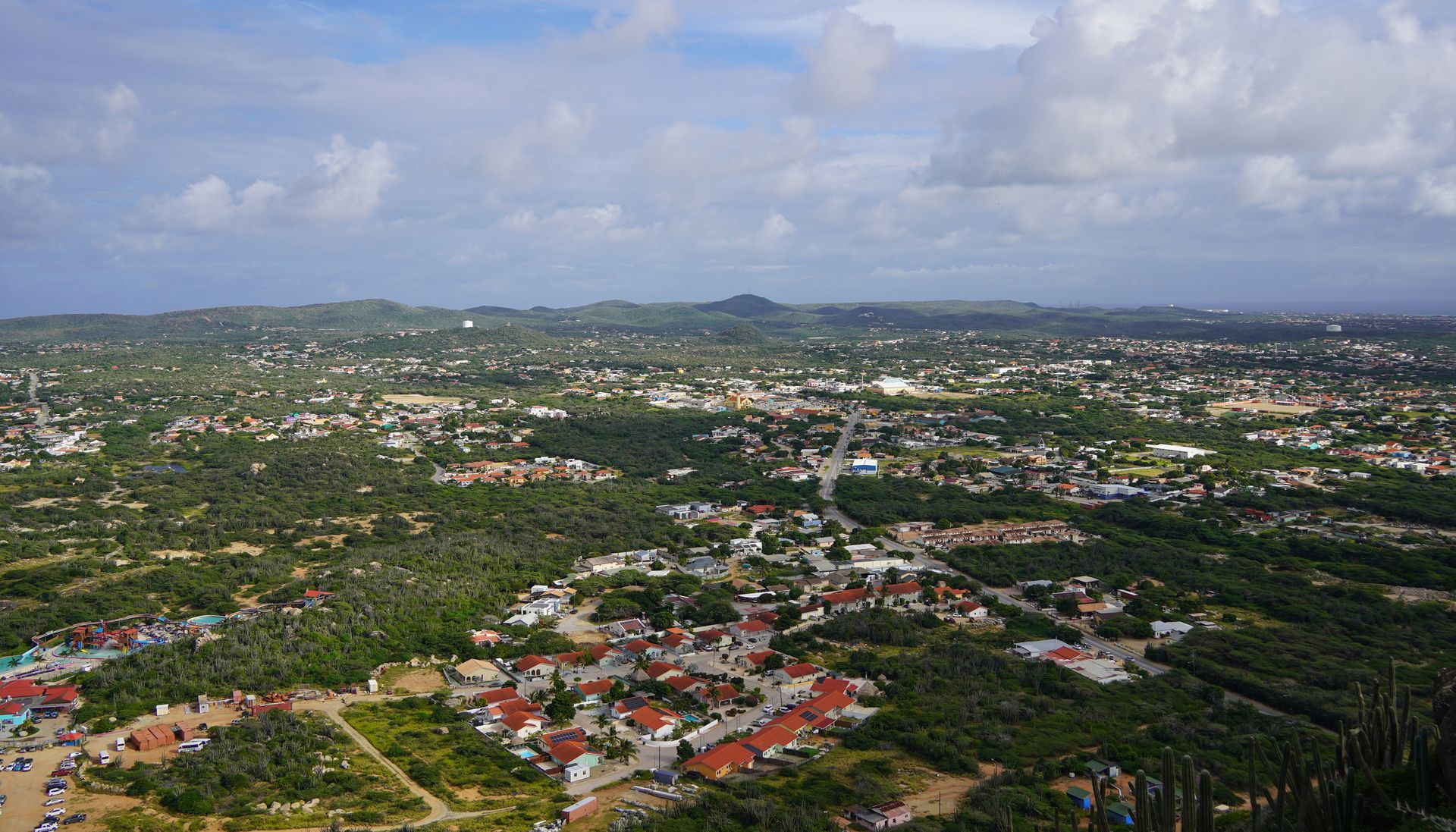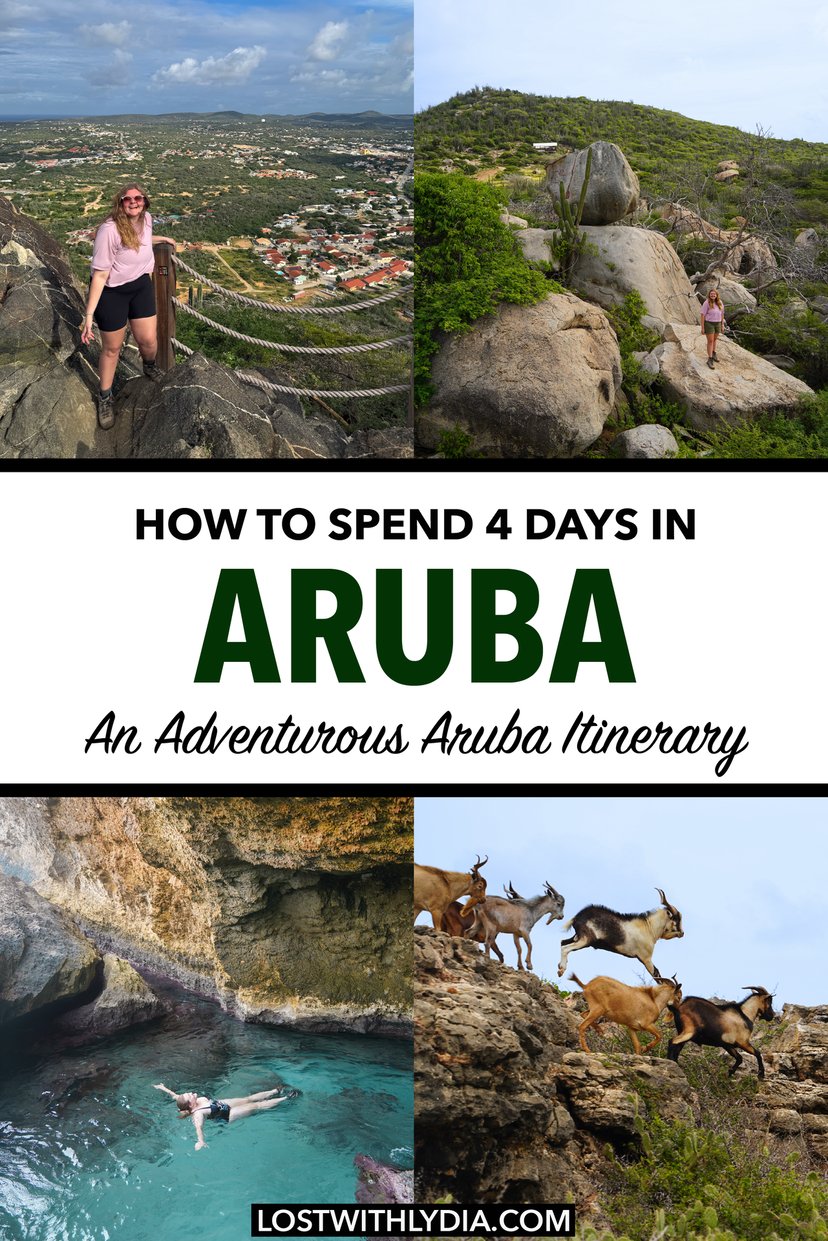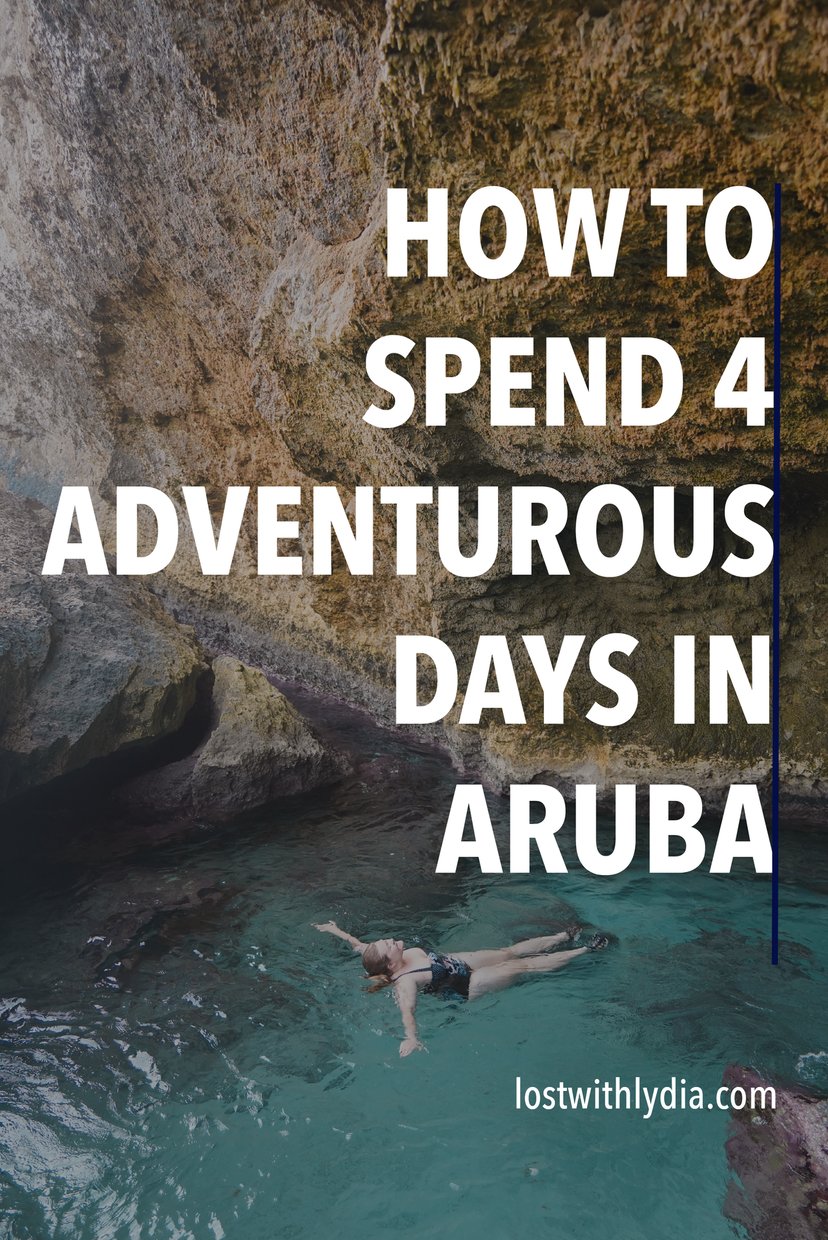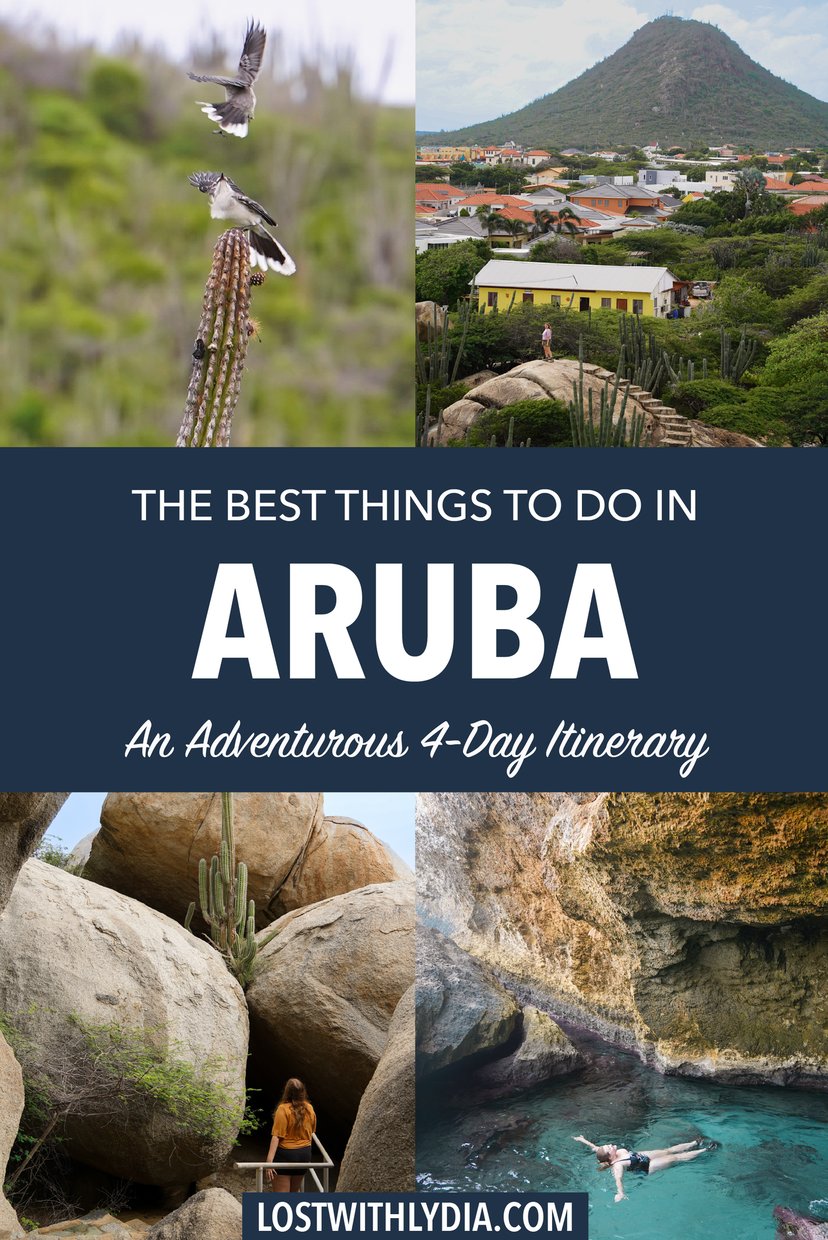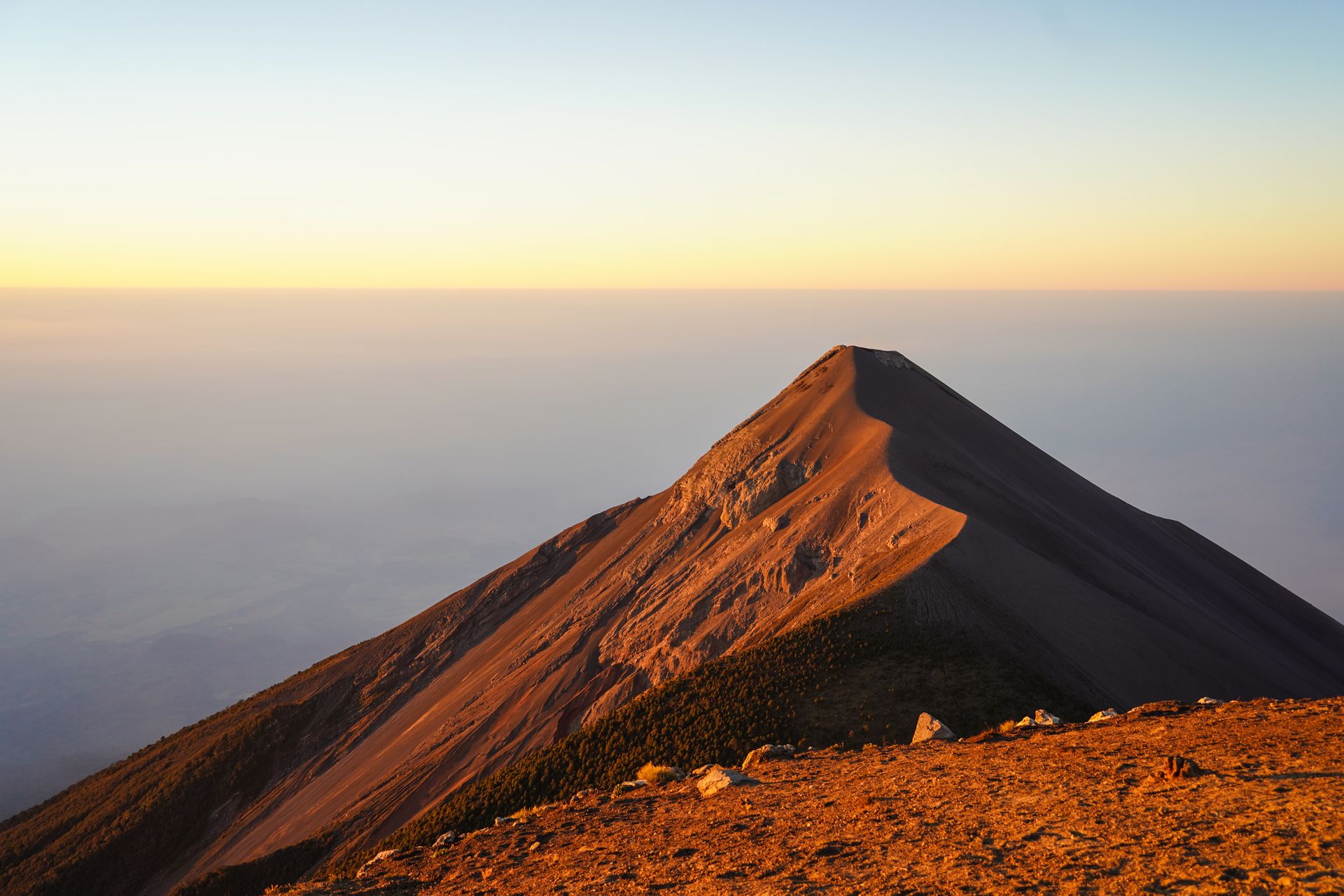If you’re more of a “I want to experience as much as I can” type of traveler vs a “I want to relax on the beach” type of person, this Aruba itinerary is for you! This Aruba guide includes hiking, snorkeling, sightseeing, a unique stay, and some cultural activities. And if you are looking to spend a lot of time relaxing on this trip, use this guide for ideas on a few adventures to add to your schedule!
Aruba is a small country located just 29 kilometers north of Venezuela. It’s part of the Kingdom of the Netherlands, so you’ll see Dutch influences in the food and other aspects of the island. Aruba has also been shaped by the native Arawak people and contributions from immigrants from countries like Venezuela and Colombia. All of these factors have made Aruba a diverse island with a mix of cultural influences.
Aruba is a wonderful choice for your Caribbean vacation because it’s safe, easy to get around on your own, has consistent weather year-round (and it’s outside of the ‘hurricane belt’ so hurricanes are rare), and is very welcoming to visitors. However, the main reason I chose Aruba was for the adventures. You can rent a jeep to explore their national park, discover hidden swimming holes, hikes among huge boulders, go birding, and more.
Fun Fact: Tourism is the largest economic driver and source of employment in Aruba. One of their other largest economies is oil refining. Aruba has one of the highest standards of living and highest GDP per capitals in the Caribbean.
I’m someone who typically chooses mountains over beaches, but I chose to visit Aruba because I was looking for somewhere that would be a little bit relaxing while still having a lot of opportunities for adventures. Aruba definitely met and surpassed my expectations in this regard, and I’d recommend it to anyone! This guide is based on my experience visiting Aruba in January 2025.
Tips and Things to know about Visiting Aruba
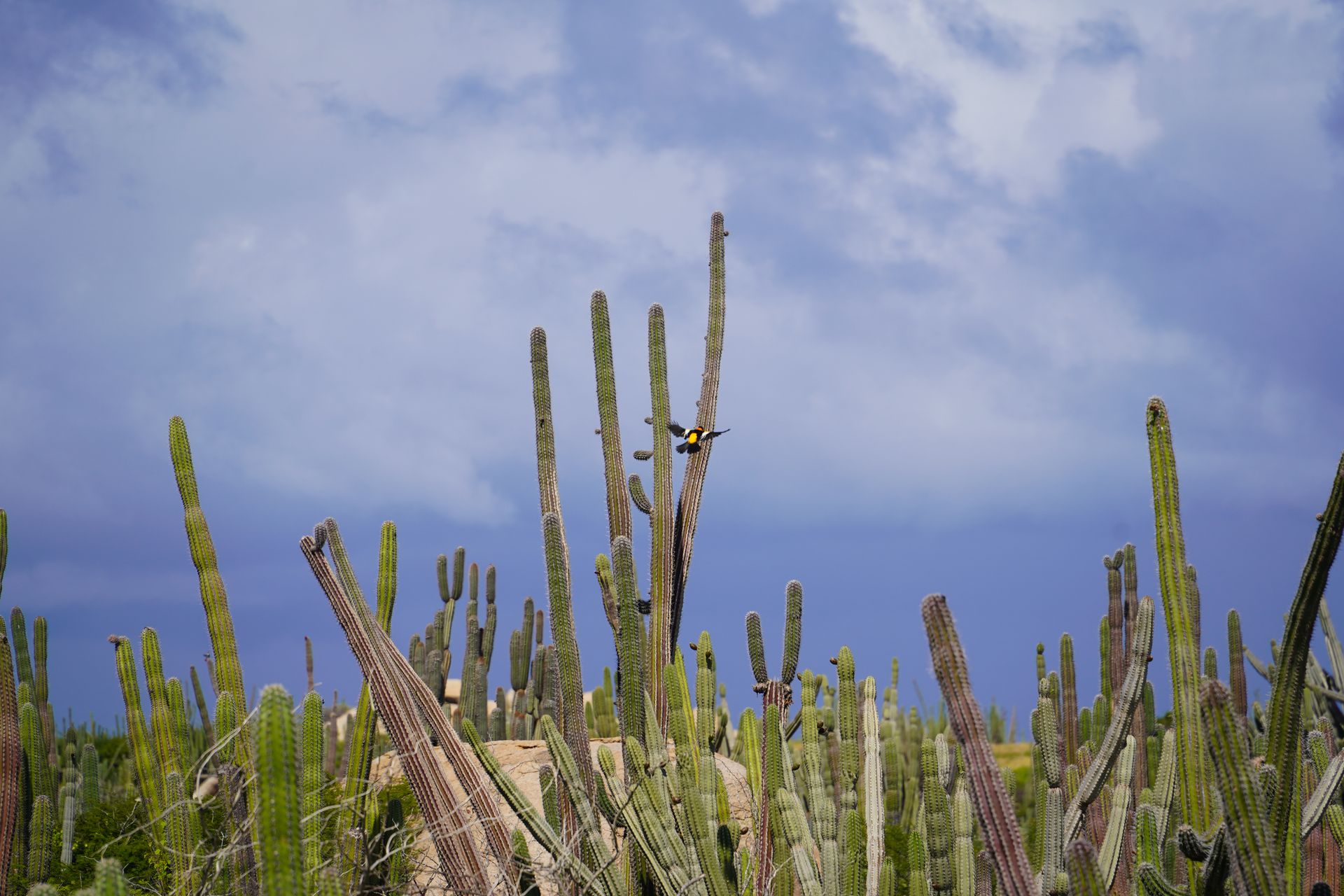
- Dutch and Papiamento are the official languages of Aruba. However, most locals speak at least 4 languages, including English and Spanish.
- Can you drink the water in Aruba? Yes! They don’t have a freshwater source, but they distill their saltwater in a desalination plant, making it safe for visitors.
- Aruba Florin is the official currency of Aruba, but the US dollar is also widely accepted. Credit cards are also widely accepted throughout the island.
- Like most islands, Aruba is pretty expensive. I found that at the grocery store, US imports were priced very high, while South American imports were a lot cheaper. Take a look at the restaurant and hotel prices ahead of time so you’re prepared to budget appropriately. While food and lodging was expensive, many of the activites in this itinerary are free!
- If you’re hoping to do a lot of exploring on your own in Aruba, a rental car is a must. I felt like it was very easy to get around the island with a rental car and definitely recommend it. (I’ll share more info below in the ‘getting around’ section!)
- It’s recommended to get to the Aruban airport about 3 hours before your flight. I found that to be sound advice, because the lines were LONG. If you’re a United States resident with Global Entry, you can expedite the process a bit, but it still meant a lot of waiting in my experience. Most of the flights seem to leave at the same time, causing back-ups.
- This varies on your phone plan, but it’s smart to have an eSIM to use your cell phone affordably during your trip. Check out Airalo for an easy and affordable eSIM!
- Generally, it’s safe to swim at the Aruban beaches on the west coast in areas such as Eagle Beach, Palm Beach and Baby Beach. However, the rocky north coast has dangerous caves and rocky shores, so it’s only safe to swim in a couple designated places.

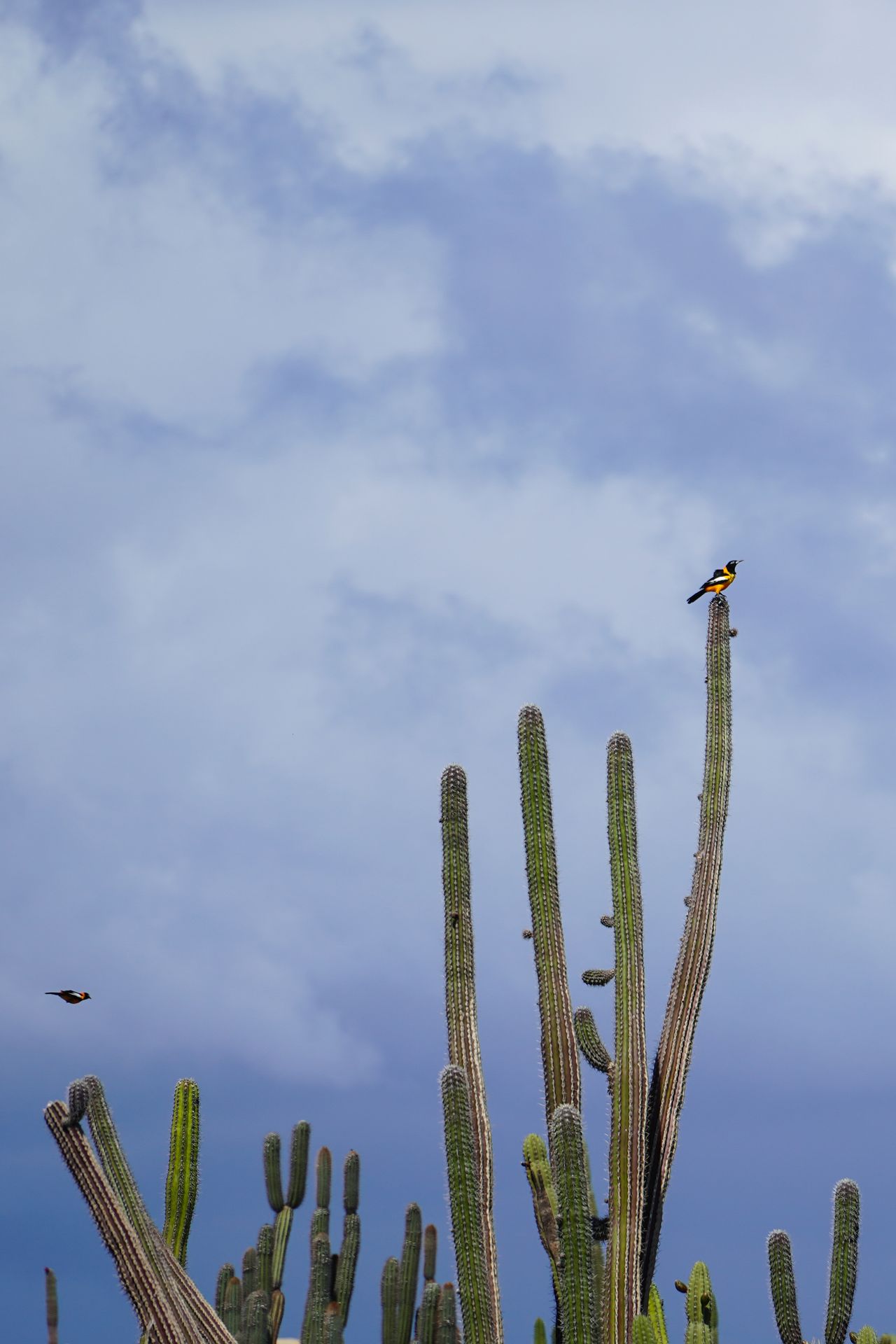
Getting Around Aruba
You can get around Aruba via taxi, rental car or public bus. I rented a car and found it to be easy to get around the island. When it comes to driving around Aruba, there are several roundabouts. Plus, there were times when Google Maps tried to take us the wrong way down one way roads, but if you pay close attention, it’s pretty straightforward.
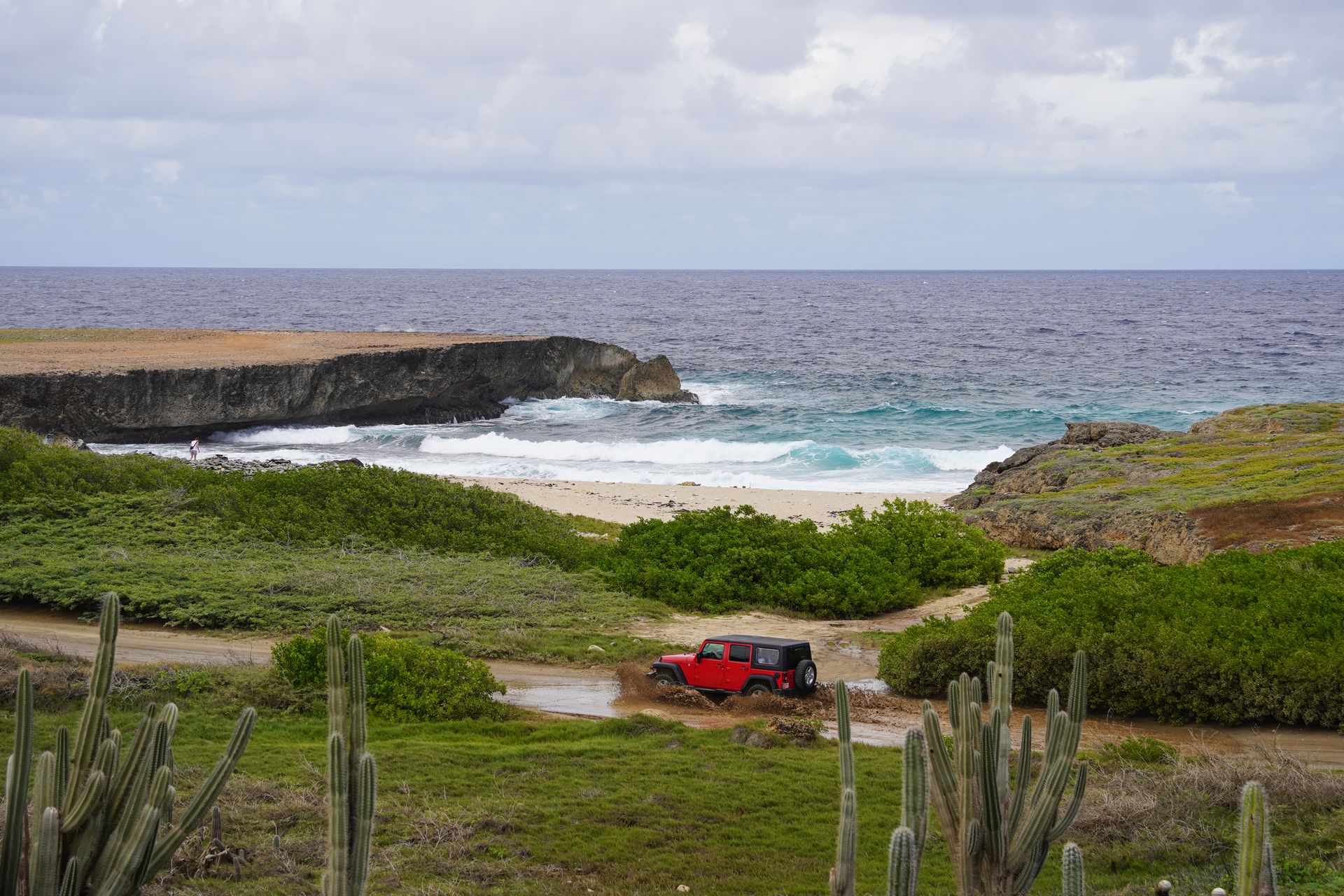
Do you need a 4x4 in Aruba? Yes, you’ll need a 4x4 vehicle if you want to explore Arikok National Park. In order to save money, we rented an economy car for most of the trip (we rented from Hertz) and only rented a 4x4 for one day. We rented our Jeep from Aruba Top Drive.
We were able to get everywhere else we wanted to go in a small economy car and loved exploring the island this way. One thing to note about our car experience was that returning the car at the airport took a LONG time. We had to park the car in a large, full parking lot and try to find someone from Hertz. Make sure to allow extra time before your flight to return your car.
Compare rental car prices using Discover Cars
When to Visit Aruba
One of the best parts about Aruba is that the island has nice weather year round! Which month to visit depends on your preference, but you really can’t go wrong.
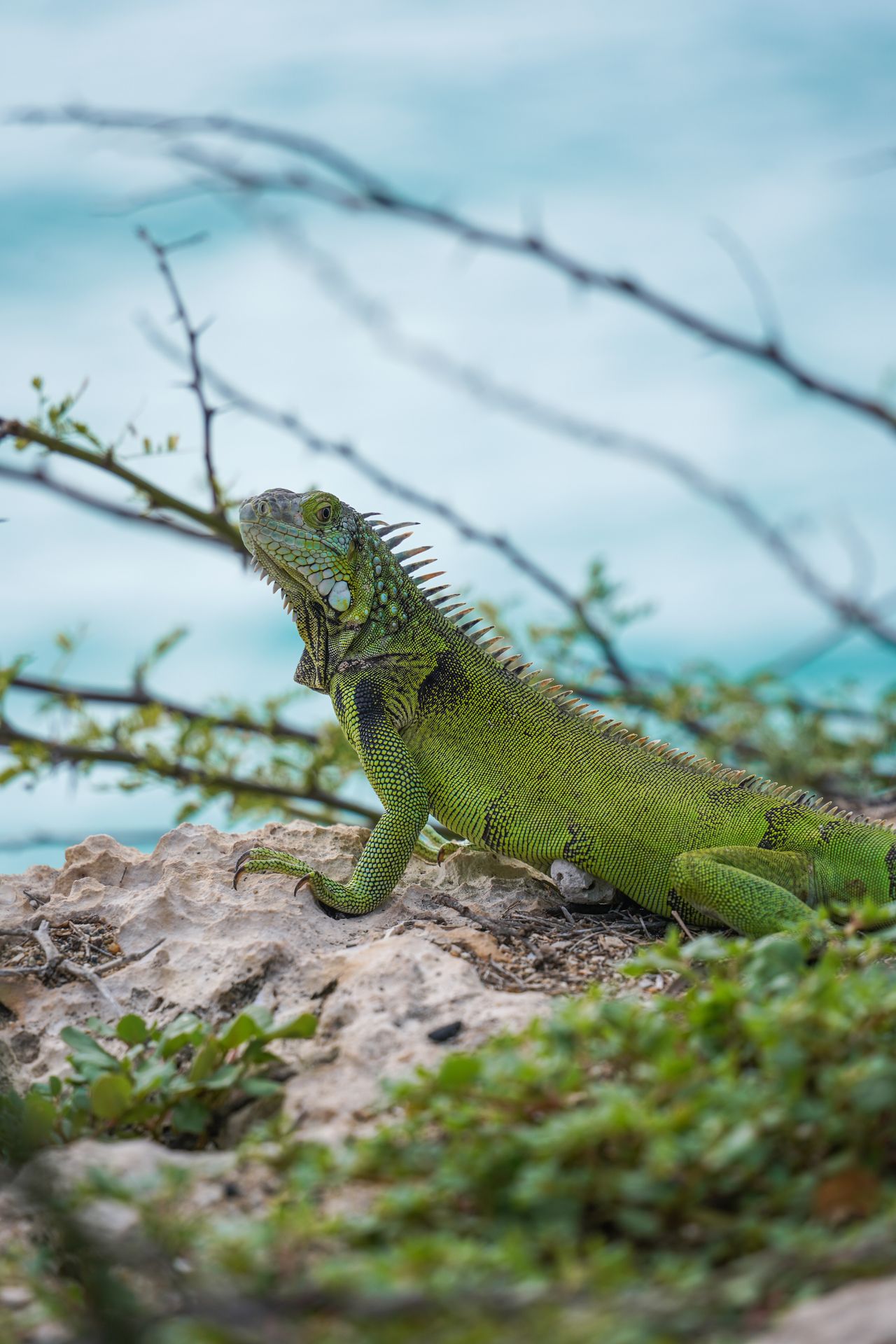

Mid-January to April tends to be the peak season, so the island can be busy. This is the dry season and when you’ll tend to have the best weather (warm temperatures without being too hot). You’ll want to make sure to book your accommodations, activities and dinner reservations in advance during these months.
October to early January is the rainy season, however, it doesn’t rain too much. You’ll typically find quick rain showers that are heavy for just a few minutes.
May to November tends to be the off season, so you’re more likely to find cheaper prices and fewer crowds.
Personally, I visited Aruba in early January and had a great experience. We did have a few heavy rain showers, but they were very quick. Overall, the weather was amazing. While some restaurants got pretty crowded in the evenings, I didn’t feel like the crowds affected my experience (and I am NOT a fan of big crowds).
How to Spend 4 Days in Aruba
Here is a map of the best places to go in Aruba!
Day One - Explore Spots on the East Side of the Island
Visit the Aruba Cave Pool
The Aruba Cave Pool is such a unique spot! This is a small natural pool that is tucked away under a rocky overhang. There is no signage marking this spot, I recommend looking for its location using Google Maps, and look for the ladder that peeks out over the cliff edge.
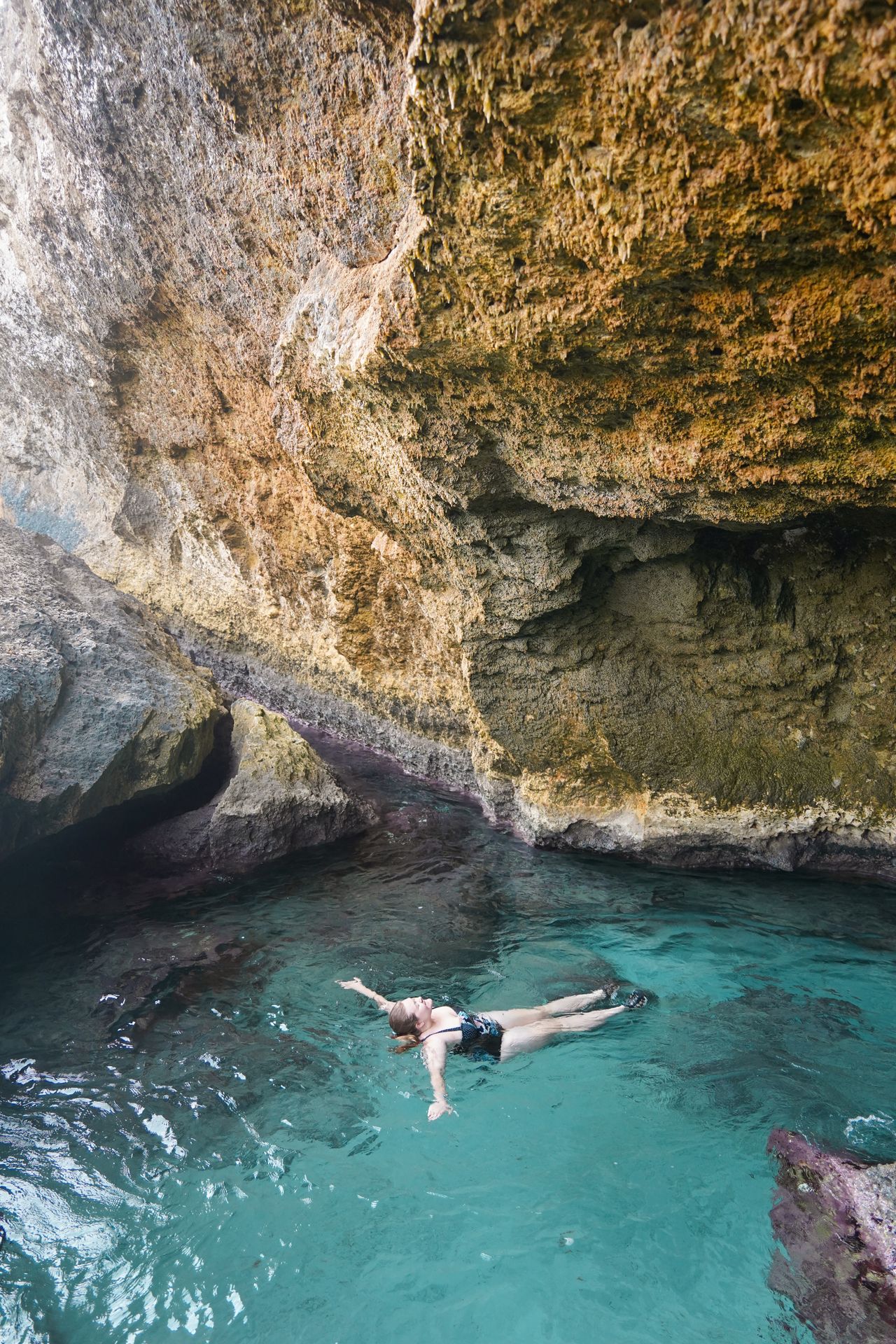

To reach the pool, you’ll climb down the ladder and then walk over some jagged rocks. Even though it’s a swimming spot, I recommend wearing water shoes with some grip (I love my Keen sandals for this!). The rocks are rugged (there were also tons of crabs all over the rocks when I visited). When you reach the pool, you can either jump or slide into the pool, and there’s a rope to help you get out.
This is a small area that a lot of tour groups visit, so I recommend going early or late if you want to have it to yourself. We visited at 7:30 AM and there was just one other couple there.
Explore the Bushiribana Gold Mine Ruins
The Bushiribana Ruins are an interesting sight right next to the Aruba Cave Pool. These ruins, along with some other remnants around the island, processed ore from mines during Aruba’s gold rush. Gold was first discovered in Aruba in 1824, and a gold rush followed.
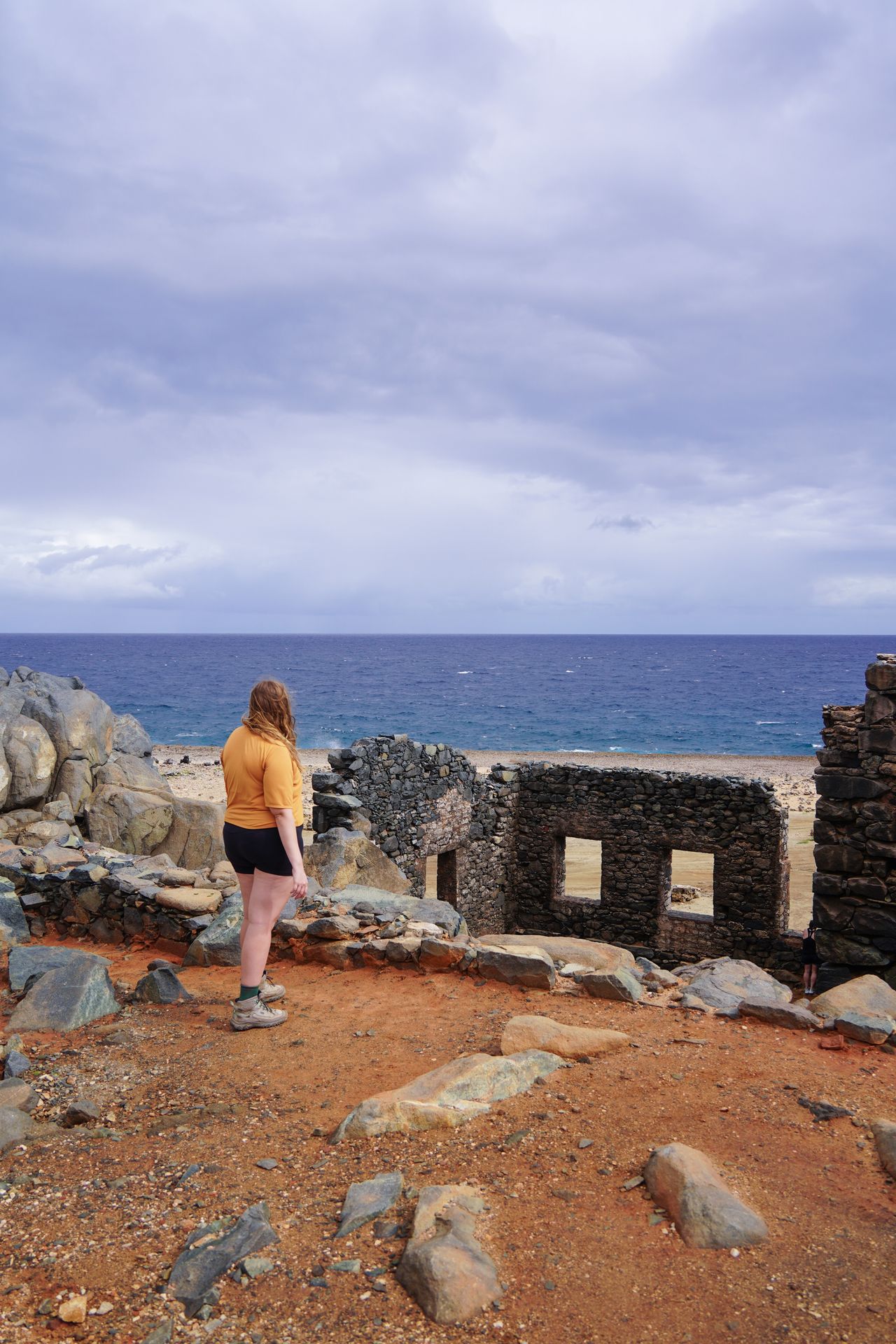
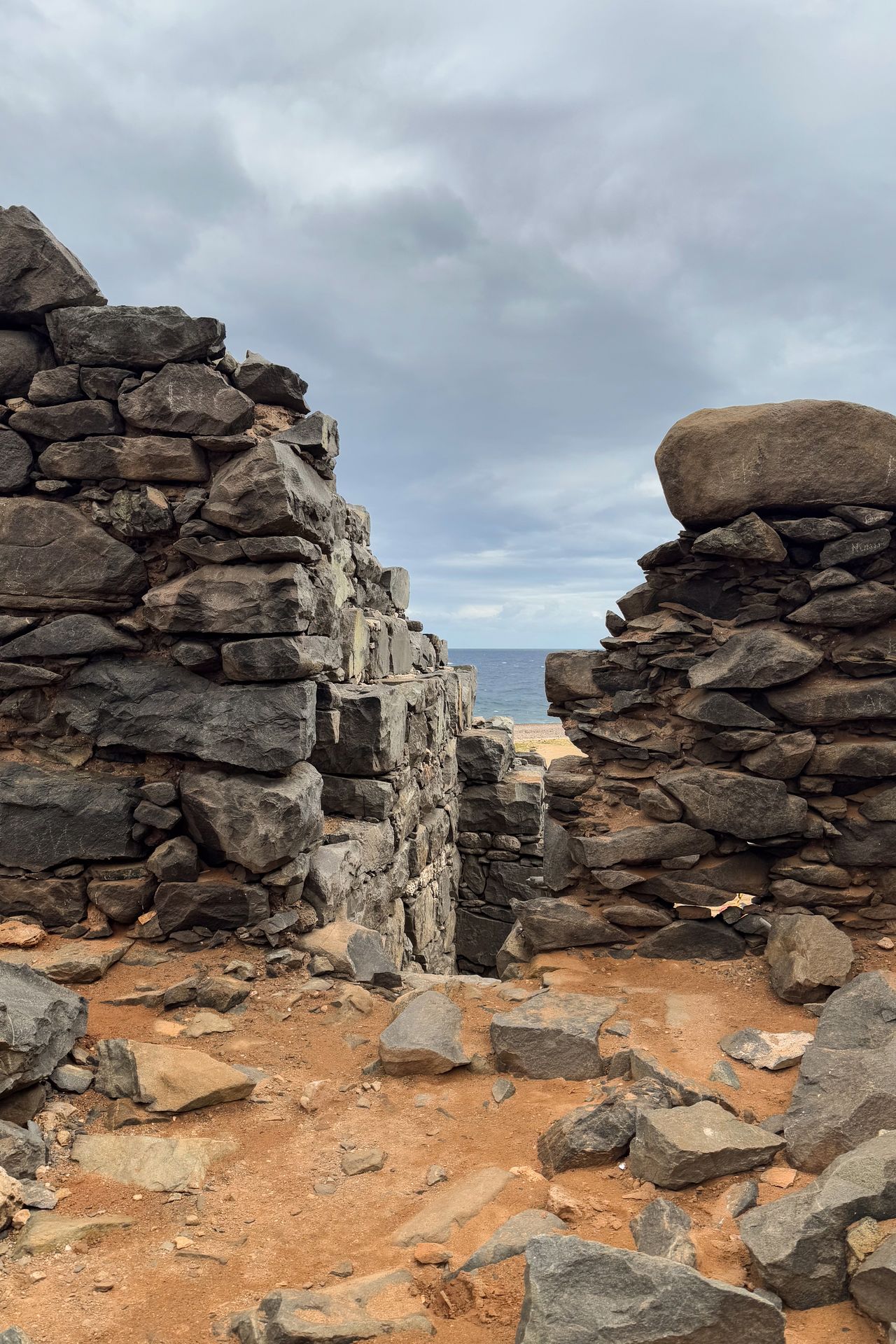
At the Bushiribana Gold Mine, you can walk inside and around the ruins. It’s an interesting structure for anyone who is fascinated by abandoned places!
Visit the Natural Bridge
The Aruba Natural Bridge is a nice stop next to the ocean. However, this is one to skip if you don’t have enough time. Unfortunately, the original and more impressive natural bridge collapsed in 2005. The bridge that remains in this spot is cool, but not as visually remarkable.

In order to reach this spot, you’ll need to drive on a bumpy, dirt road. During my visit, we also had to do a small river crossing in our vehicle. My economy car made it just fine, but a 4x4 and high clearance vehicle would certainly be a safer and more comfortable choice.
Tip: There is a gift shop and restroom here, but bring small bills to use the restroom.
Overall, this was a nice spot to enjoy some ocean views, but was one of the most crowded spots I visited. I recommend going early in the morning if you’d like to avoid the tour groups.
Explore the Ayo Rock Formations
The Ayo Rock Formations offer a short but interesting trail through giant boulders. These towering boulders were considered sacred by the original inhabitants of the island, and you can see petroglyphs here today.


The hike around the boulders is about a half mile and includes some steps. The most unique part is that the trail leads you right between some of the rocks, so you’ll find yourself ducking and using your hands as you navigate through.
Along the way, you’ll likely spot plantlife and might even see some wildlife. I loved this quick stop for an easy hike in Aruba.
If you’d like to explore these places with a guide, an ATV tour is a great way to explore this side of the island! This tour includes stops at the Cave Pool, the Natural Bridge and more.
Explore the Casibari Rocks
The Casibari Rocks are similar to the Ayo Rock Formations, but are more popular for tourists (aka more crowded). The small park has some large and interesting piles of boulders, and they’ve built railings and steps into the rocks, so you can climb to the top. You can get some lovely views of the island this way!

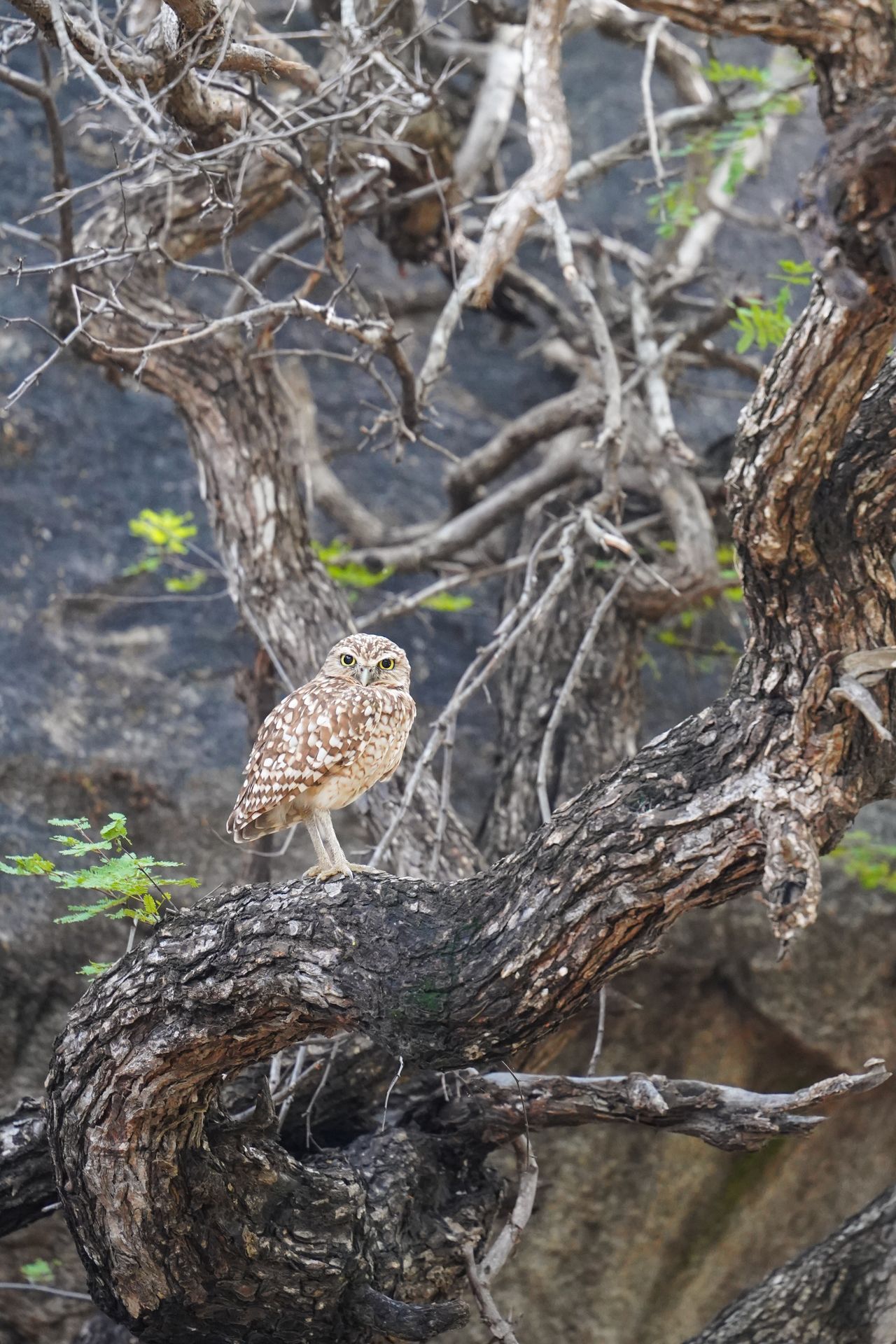
This was a beautiful place for bird watching - we saw a burrowing owl and several other birds here. I slightly preferred Ayo Rocks, but the Casibari Rocks are also worth a visit if you have the time and enjoy places like this!
Day Two - Go Snorkeling and Explore the North Part of the Island
Snorkel at a Shipwreck
Snorkeling or scuba diving is one of the best things to do in Aruba! Aruba is surrounded by several shipwrecks, which are super interesting to see under the water. I went on a snorkeling tour with Aruba Watersports Center that included two snorkel spots, along with snacks and alcoholic drinks.
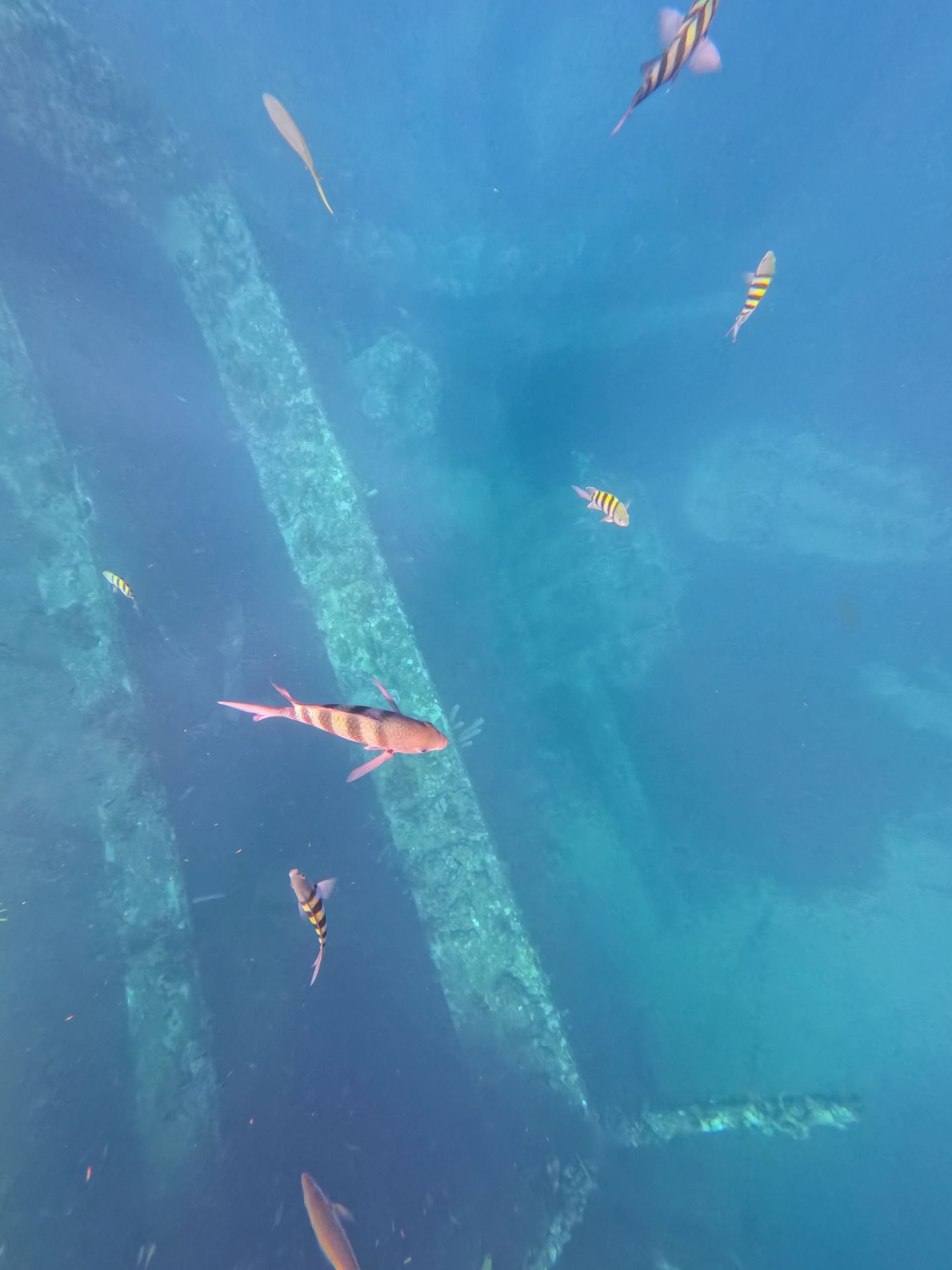

Our first stop was the Antilla Shipwreck. This is a 400-foot German ship that was deliberately sunk in 1940 (during WWII) in order to avoid being captured by the Dutch. The ship sits on its side in a shallow area, making it an interesting and accessible spot for snorkelers and divers.
Our second stop was calmer and a nice spot to spot fish, turtles and marine life. This was also a great spot for jumping off the boat.
This tour definitely had a party vibe, with music, alcohol being served right away and energetic guides. Most of the snorkeling tours I looked at seemed similar, so arrive ready to have a good time!
Book the snorkeling tour I did on Viator
Visit the Alto Vista Chapel
The Alto Vista Chapel is a picturesque stop with lovely views. It’s a Catholic Chapel up on a hill that was first built by a Spanish missionary in 1750. From the chapel, you can enjoy great views of the ocean.

The chapel is surrounded by several trails that weave among cacti. This is a popular area for mountain biking. There is also a neat little labyrinth next to the chapel. This area is free to visit and is great for a quick photo spot, or a nice starting point for a hike or biking adventure.
Visit the California Lighthouse
Head to the top of the tallest structure in Aruba for islandwide views! The California Lighthouse sits at the Northern tip of the island and you can climb to the top for $5 per person. It was built in 1916 and stands over 90 feet high.
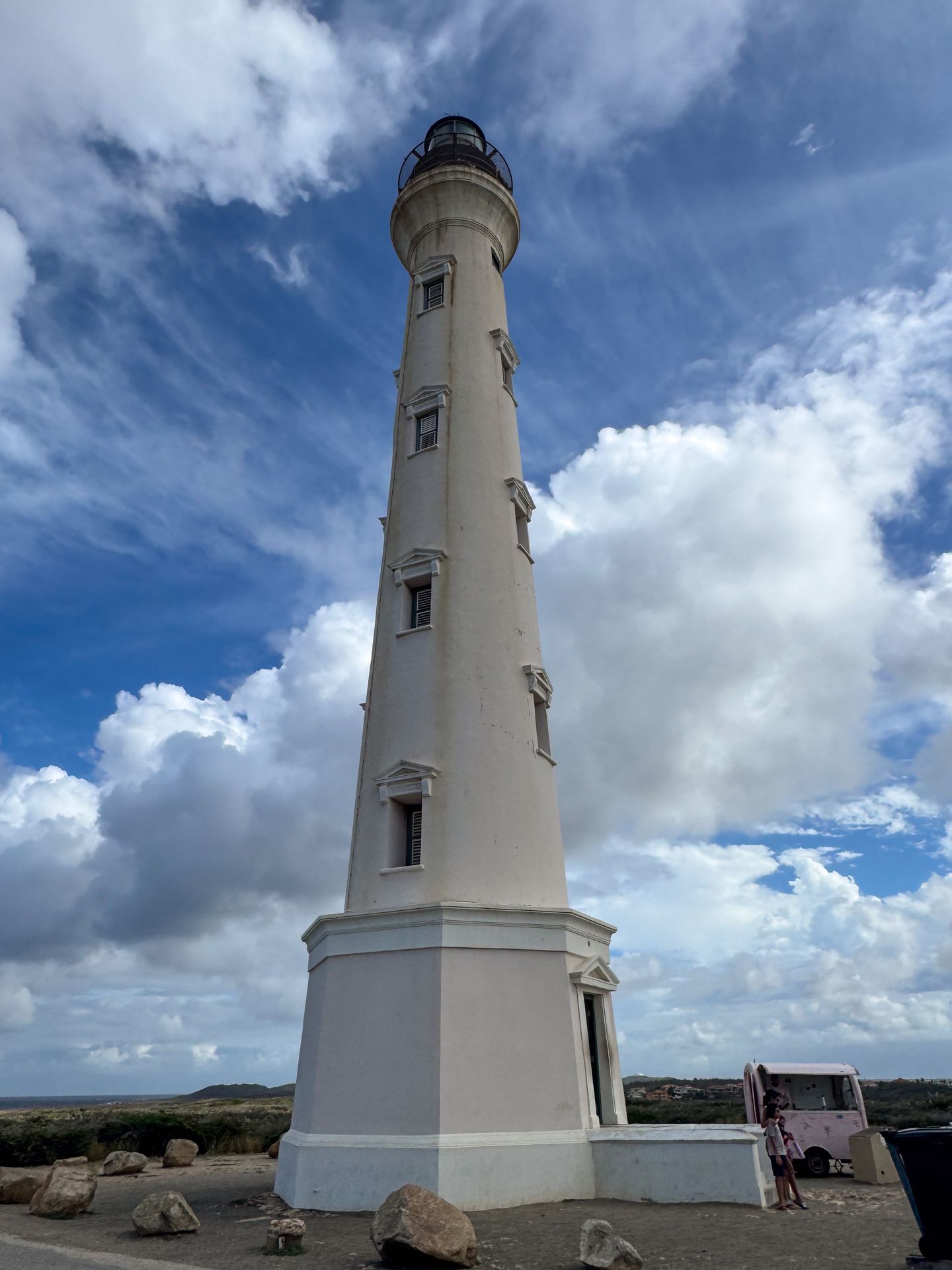
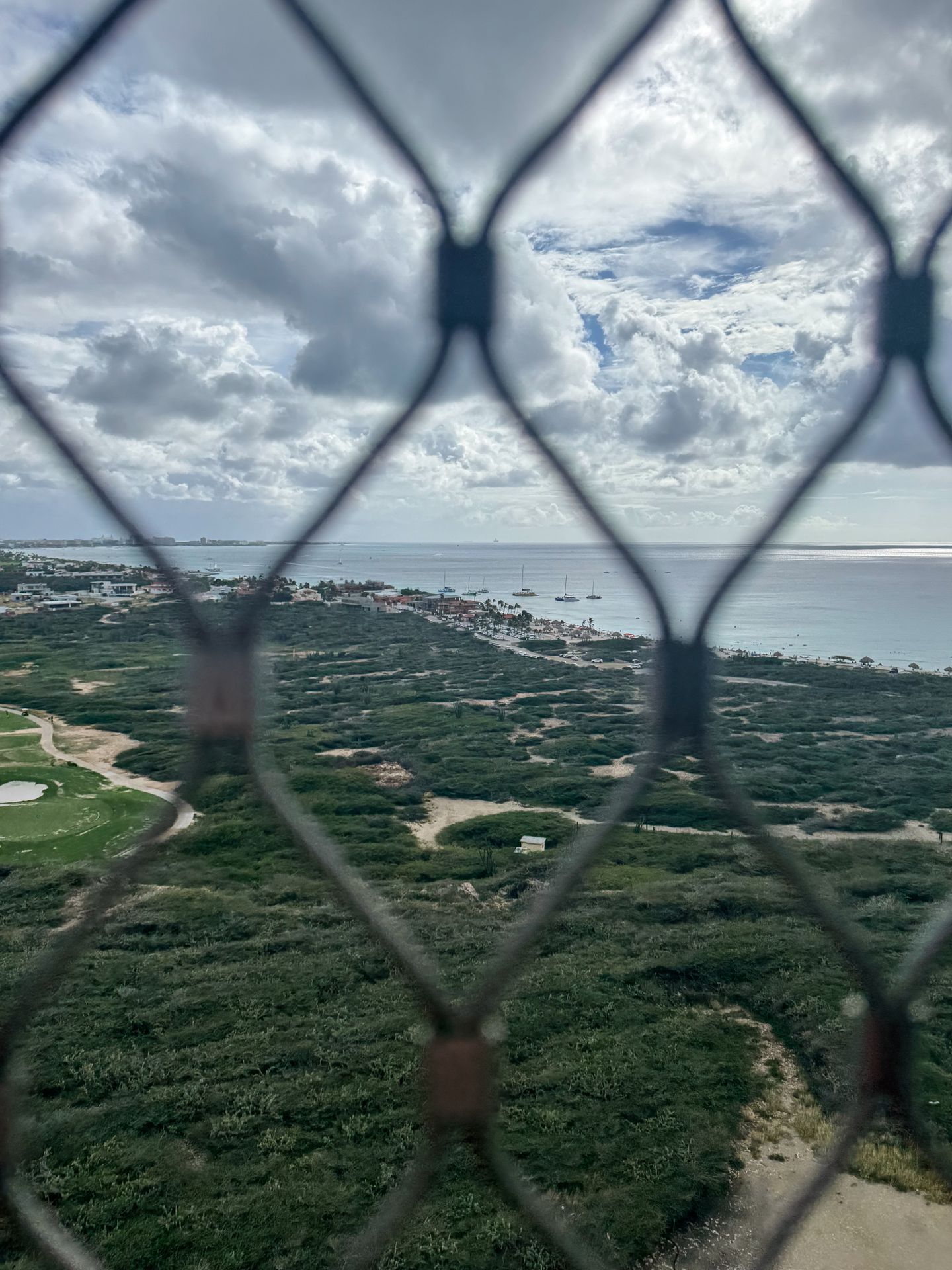
You’ll need to traverse a narrow staircase with many steps to reach the top. Wear comfortable shoes and enjoy the workout with rewarding views!
Take a Tour at the Aruba Aloe Factory
The Aruba Aloe Factory Museum and Store is a great place to learn all about aloe. They offer free tours where you can learn about the historic importance of aloe in Aruba, what aloe is used for, why it grows so well in Aruba, and more!

Fun Fact: Aloe is the only export of Aruba.
Aloe used to be a huge part of the Aruban economy, but today, there is only one field left. Originally, it was primarily used in laxative pills, but today it’s used for skincare. The Aruba Aloe brand makes sunscreen, soaps, lotions, and even creams that offer medicinal benefits, such as healing scars.
I really enjoyed the tour. Our guide was very informative and it didn’t feel overly salesy. I couldn’t resist picking up a few items from the gift shop, and have especially enjoyed using the aloe soaps at home. This is a great place to learn about how useful the aloe plant is and pick up a useful souvenir or gift.
Day Three - Hike to the Tallest Peak, Go Beach Hopping and Take a Sunset Sail
Hike to the Tallest Peak in Aruba
If you enjoy hiking, it’s well worth the quick hike to reach the highest point in Aruba! This mountain stands alone in a central part of Aruba and is shaped like a cone.
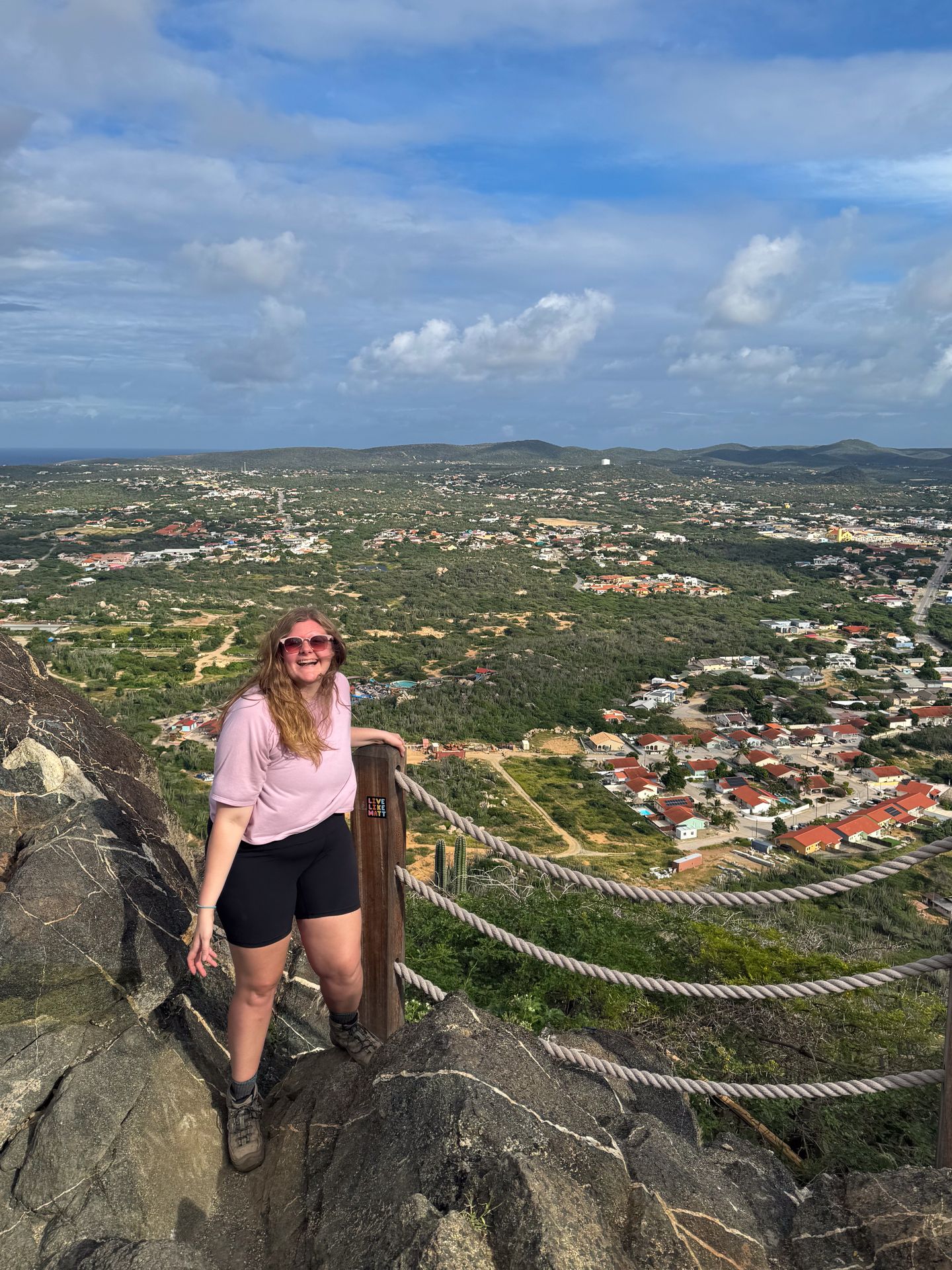
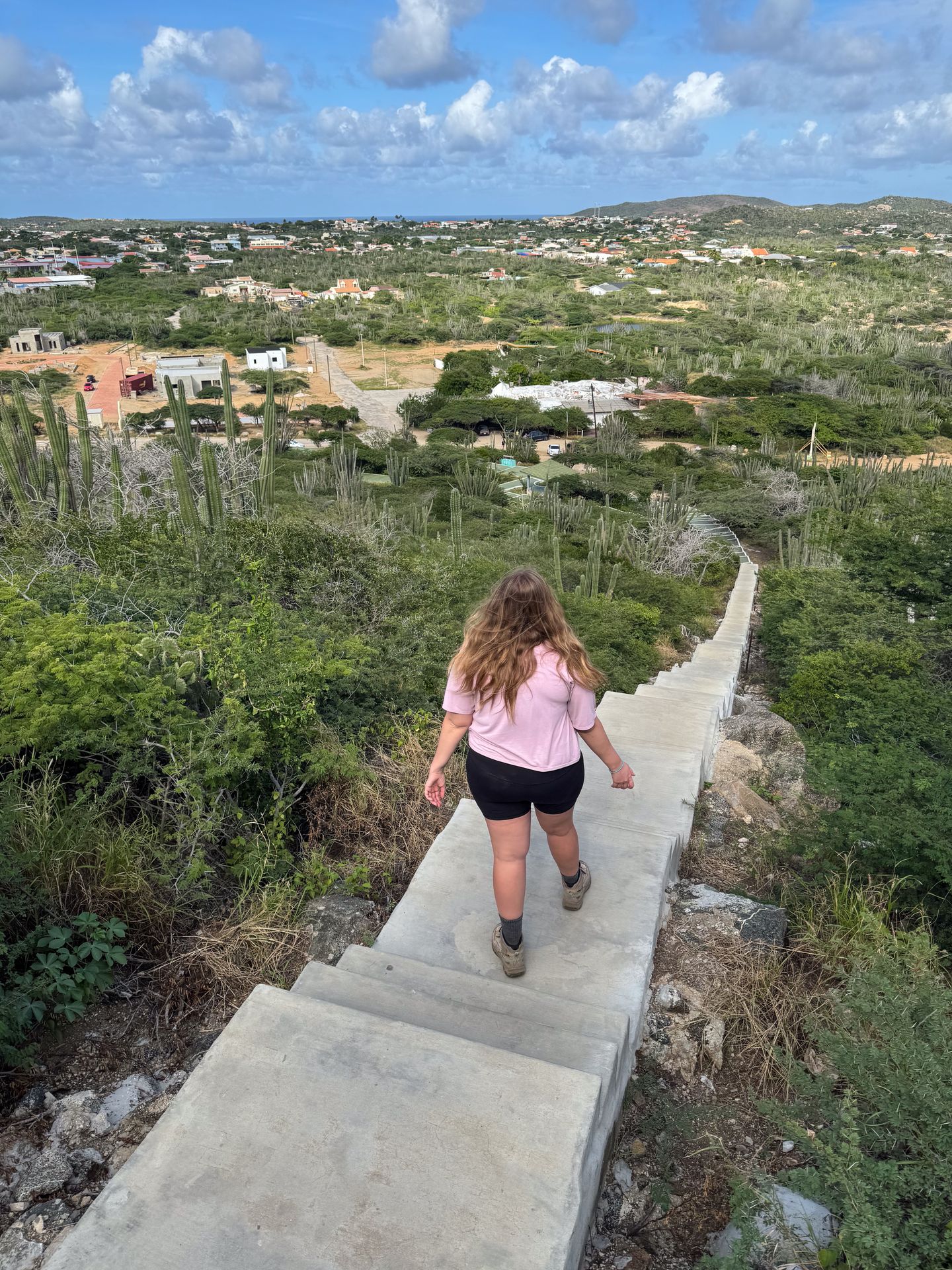
It’s just a quarter mile to reach the top of Mount Hooiberg, but you’ll be climbing up 600 steps and gaining over 300 feet of elevation. The top of the mountain has some epic 360-views of the island and it’s a fun climb!
Go Beach Hopping
Spend your afternoon checking out some of the most iconic beaches in Aruba. I really enjoyed the secluded views at Mangel Halto Beach. There are mangrove trees along the shore, creating shady areas and peaceful nooks to relax. This is also a great spot for snorkeling and shore diving (you can walk out to a reef).
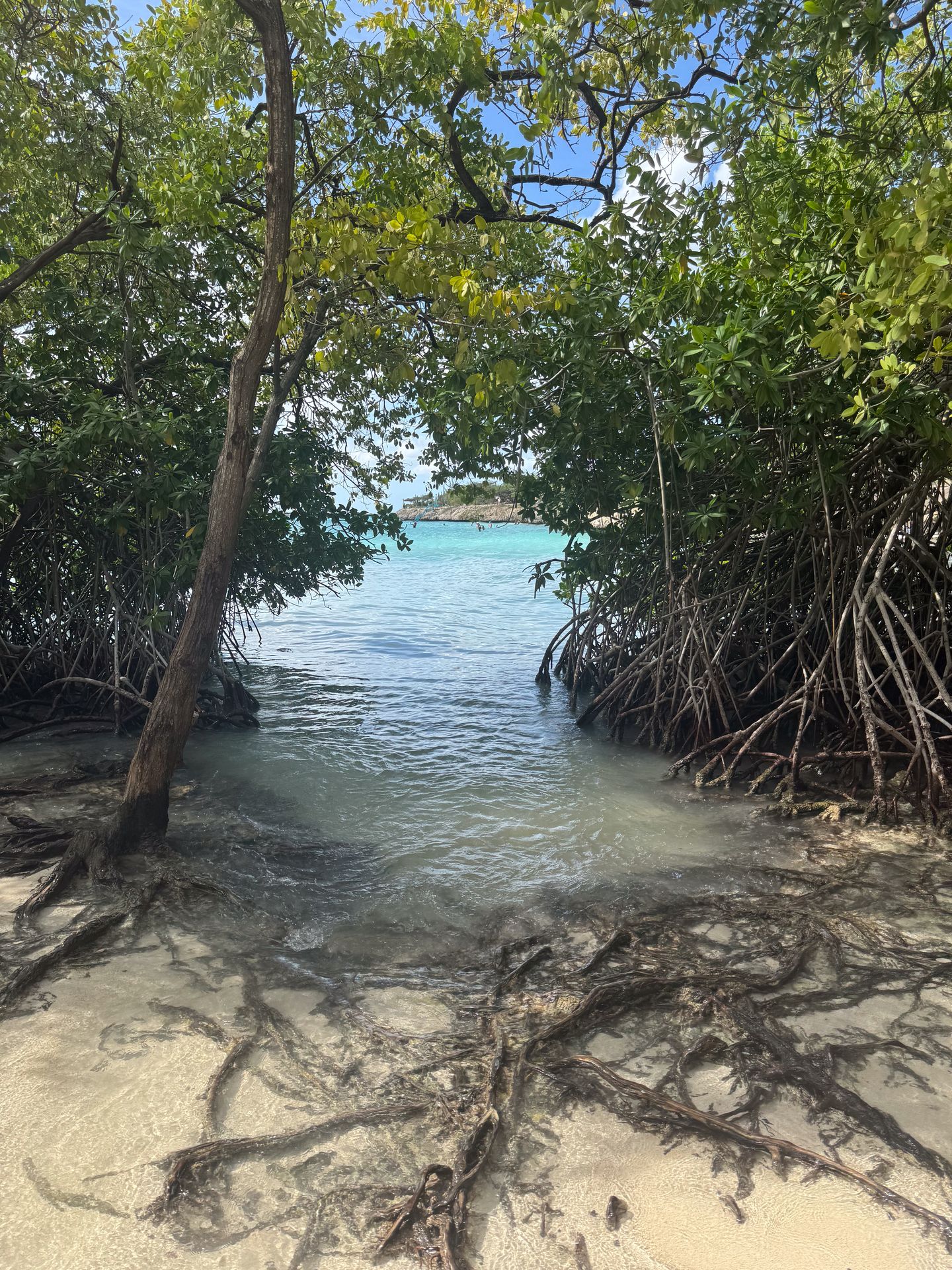
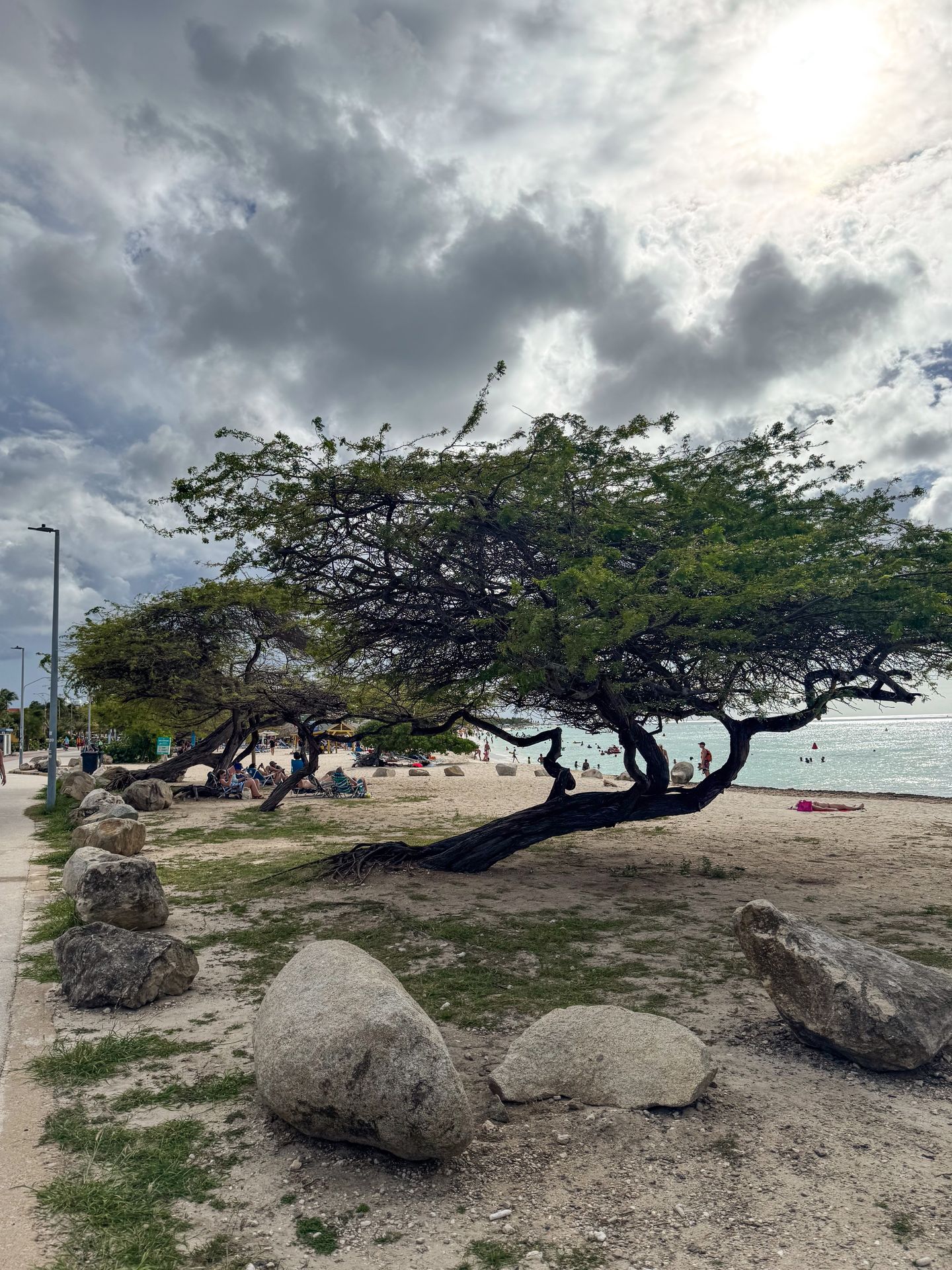
Fun Fact: There are over 20 public beaches in Aruba.
Another interesting beach to visit is Eagle Beach. This is the widest beach in Aruba and has the perfectly soft, white sand that you’d expect in the Caribbean. However, I think the most interesting part of this beach are the famous fofoti trees.
The fofoti trees are native to Aruba, and characterized by their twisted roots. One of these trees at Eagle Beach sits atop the sand and grows out towards the ocean, making it a popular spot for photography.
Take a Sunset Sail
End your day by getting back out on the water with a sunset sail! I spent a great evening with Octopus Sailing Charters. We sailed out on a catamaran and enjoyed cocktails and light bites along the way.
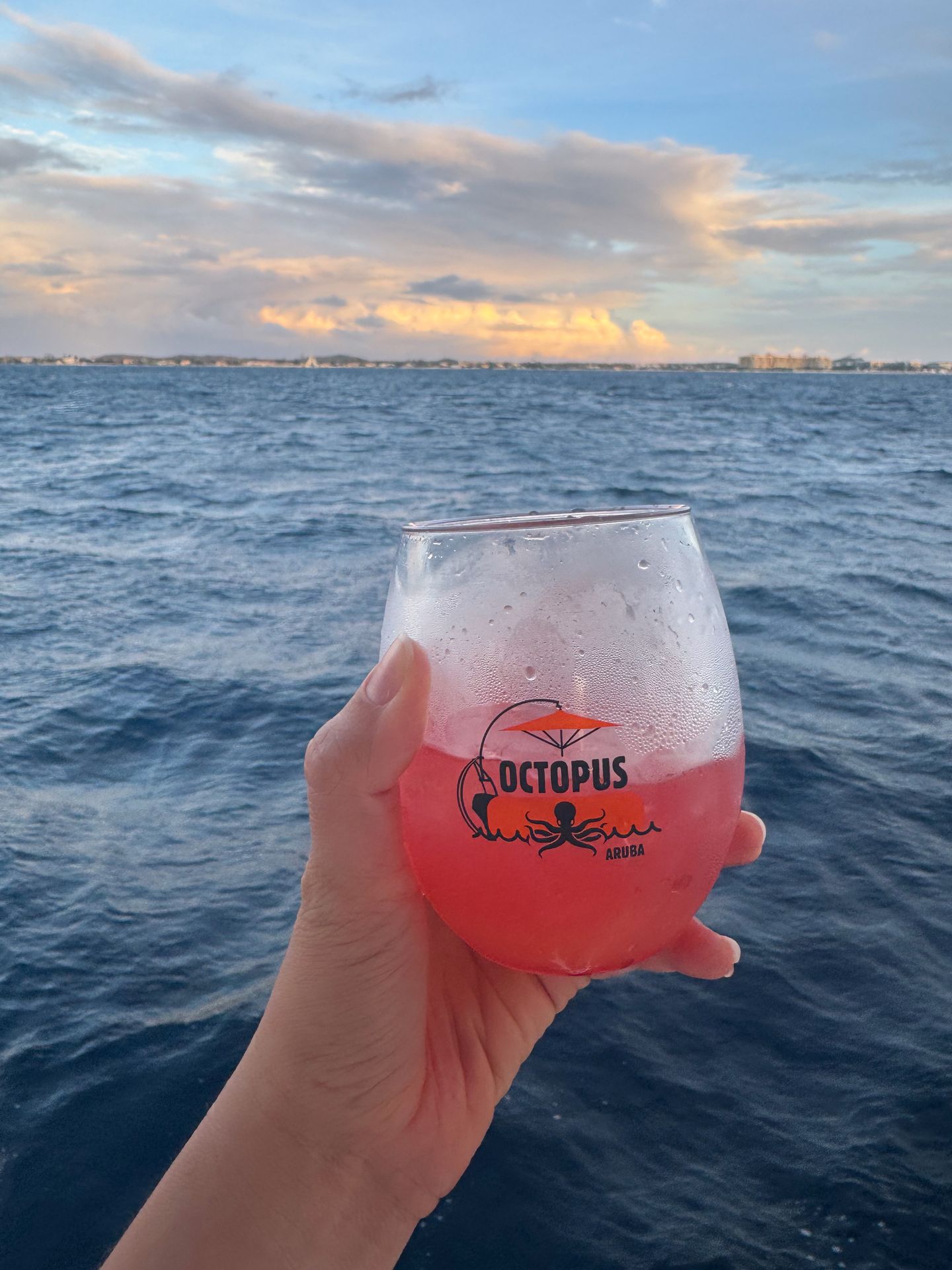

I went out on a cloudy evening, so the sunset wasn’t the greatest. But it was still a really fun night. They served 4 different cocktails (or could mix whatever you wanted). Plus, they kept the snacks coming with items like bruschetta, hot dogs, fruit skewers, and more.
This makes for a fun romantic evening, or a great activity with friends. You’ll arrive back just in time to enjoy dinner in the bustling area of Palm Beach.
Book the sunset sail I did on Viator
Day Four - Rent a Jeep and Explore Arikok National Park
If you’re looking for an all-day adventure during your trip to Aruba, you can’t miss Arikok National Park! The park makes up about 20% of the island and protects flora, fauna, wildlife, petroglyphs and more.


Most of the park is only accessible with a 4x4 vehicle, so you’ll need to have the right vehicle or join a guided tour. We rented a jeep just for the day, which worked out great. We rented from Top Jeeps inside of the Barcelo Hotel.
When you arrive at Arikok National Park, you’ll need to park at the visitor center, go inside and pay a fee. They asked what type of vehicle we had and explained how to reach our first stop on the 4x4 route. The park rangers were very helpful and informative!
The visitor center also has restrooms, exhibits about the park and a cafe.
Swim at the Conchi Natural Pool
Our first stop in the national park was Conchi Natural Pool. A 4x4 vehicle is definitely needed to drive to this spot. The road was bumpy with deep mud, large rocks and steep hills.
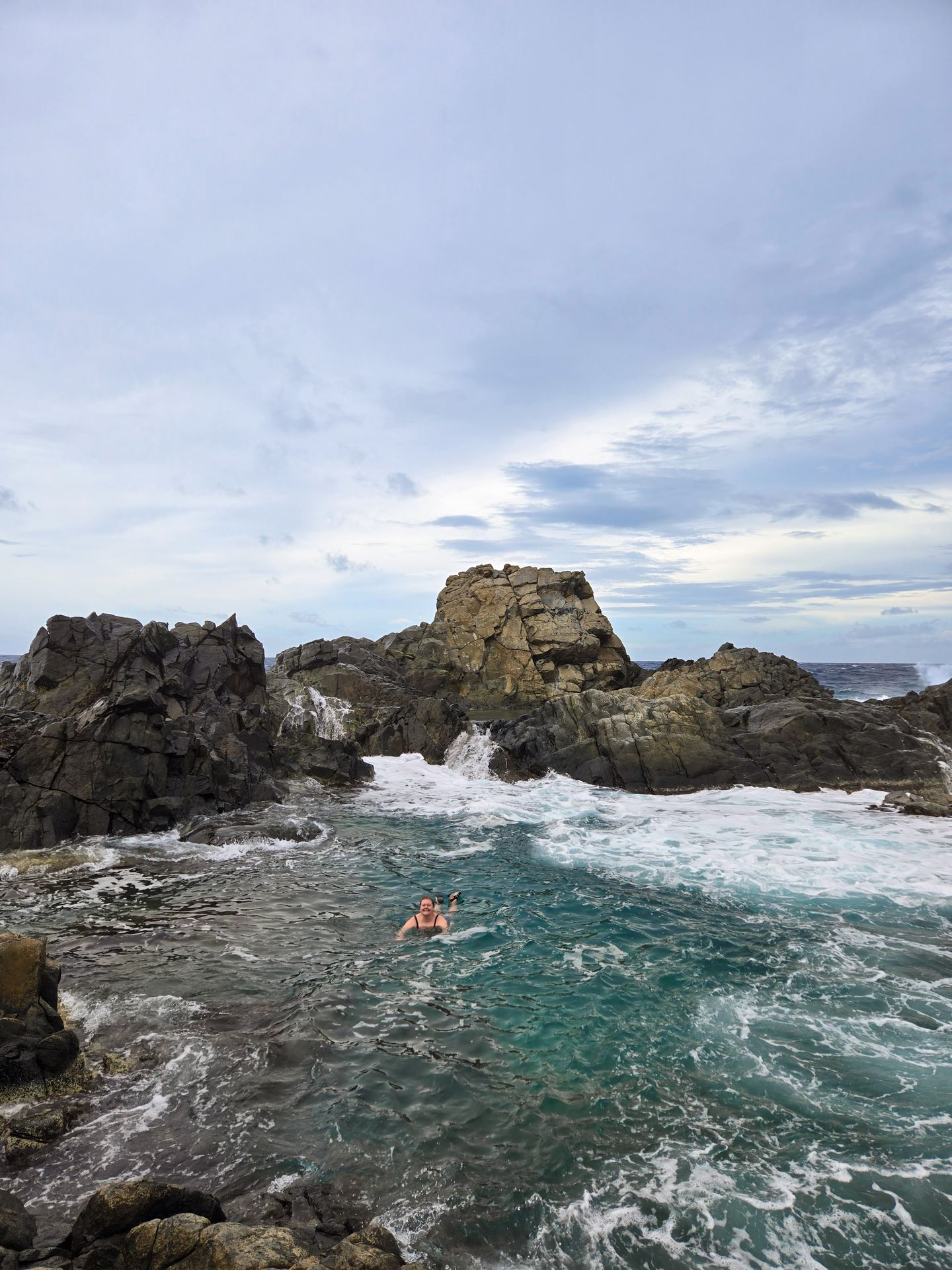
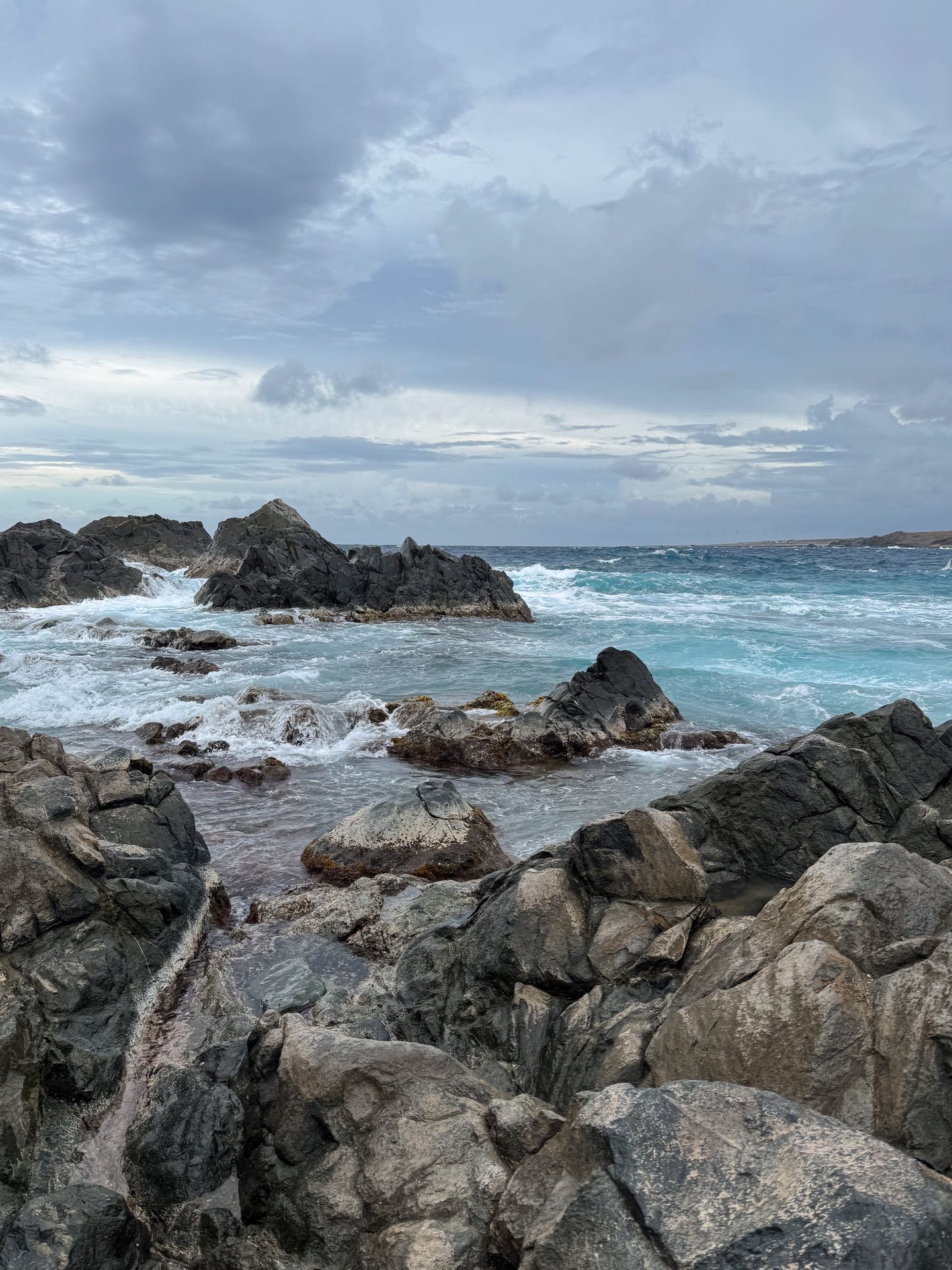
Tip: If you don’t have a 4x4 vehicle, there are routes to hike to Conchi Natural Pool. But a 4x4 vehicle will take you right next to the pool.
After reaching the parking area, you’ll need to climb down some rocky steps to reach the water.
The pool is unique because volcanic rocks have created a small dip and a protected area of water. The pool is typically tranquil, however, the water can still be rough from the ocean rushing in on a turbulent day.
At the pool, there were two workers acting as lifeguards and providing advice on how to visit safely, which was very helpful. The ocean was rough that day, so there were huge waves coming into the pool at times. However, the pool is just protected enough that we could enjoy the peace for a couple minutes before a large wave would come in, and we would be soaked and/or thrown off balance.
This was a gorgeous and unique sight, and definitely a must-see for your Aruba itinerary!
Visit the Caves in Arikok National Park
There are two popular caves inside of Arikok National Park - Fontein Cave and Quadirikiri Cave. Fontein Cave is small and known for its drawings by the Arawak Indians on the cave ceiling.
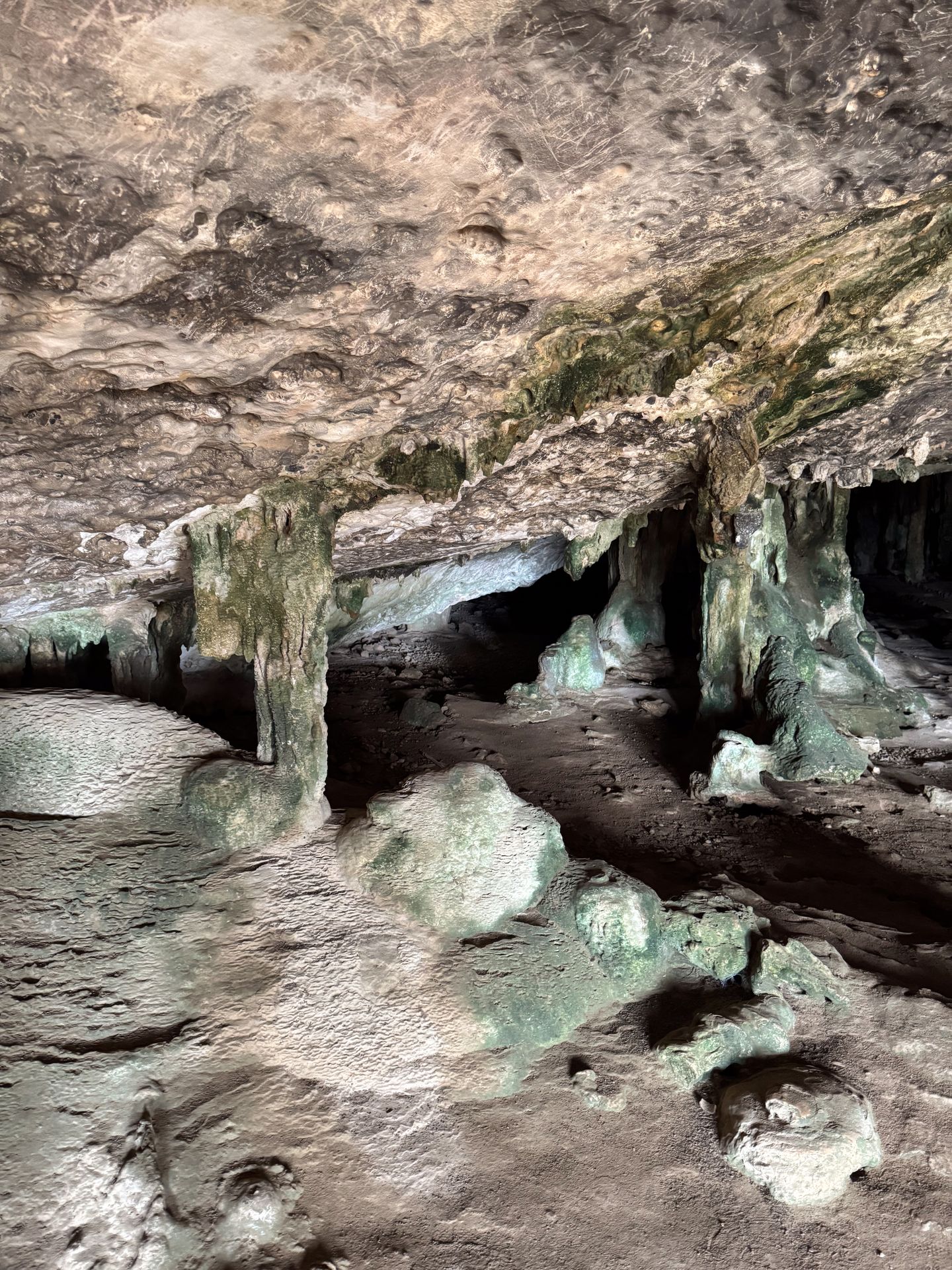
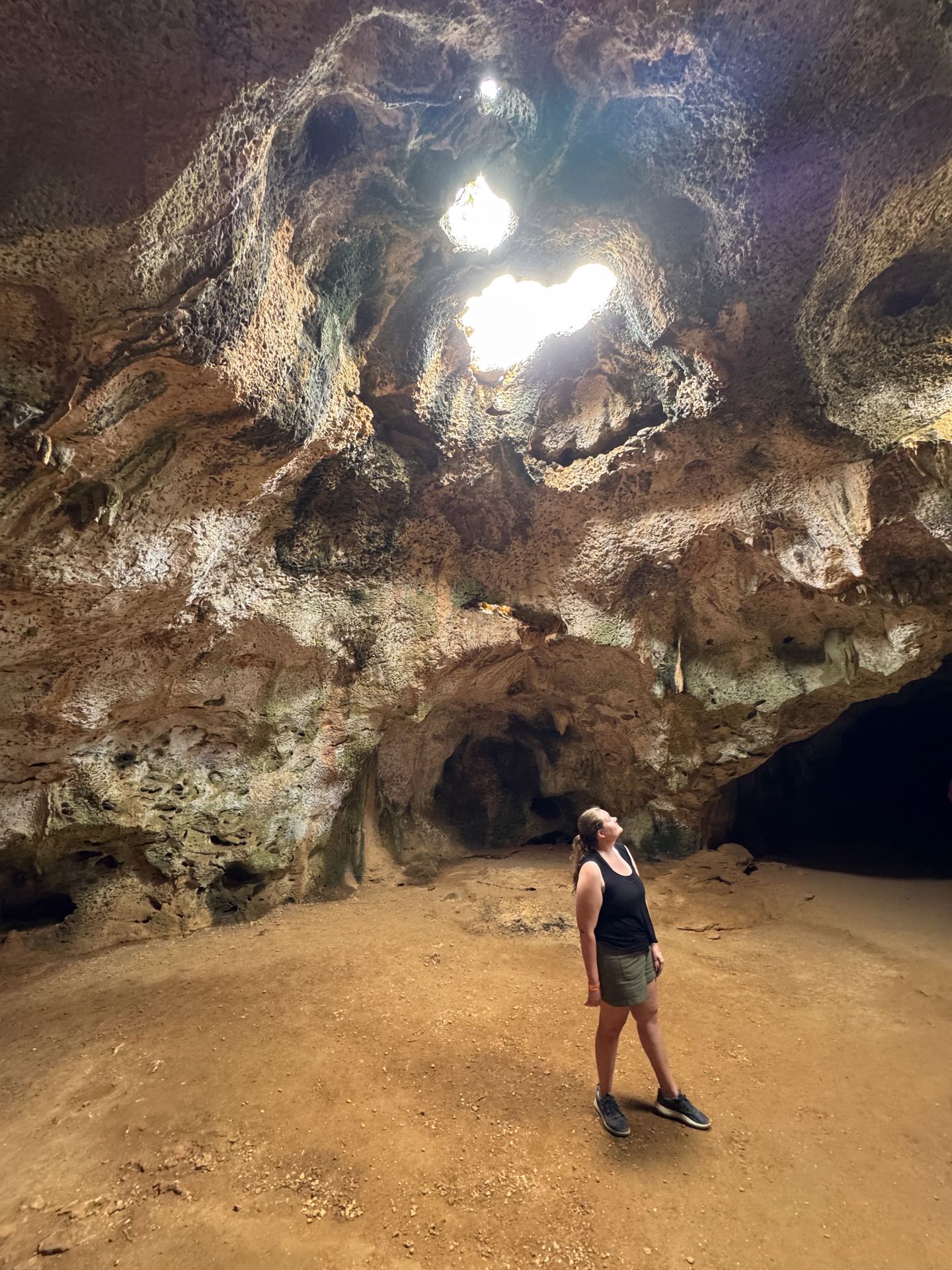
Quadirikiri Cave is much larger and famous for the sunlight that pours through from openings at the top of the cave. The cave is about 100 feet long and is home to 100s of bats. Both caves are worth a visit.
In addition to the caves, we enjoyed stops at a few of the beaches in the park. We also saw many goats in the park, including a herd that rushed across the landscape. Unfortunately, I read that the goats are an invasive specie, but they’ve been living on the island so long that it’s hard to know what it would be like without them.
Where to Stay in Aruba
The Most Unique Place to Stay in Aruba
Personally, I’m always looking for a more unique stay vs a typical hotel, and I found an amazing stay in Aruba!
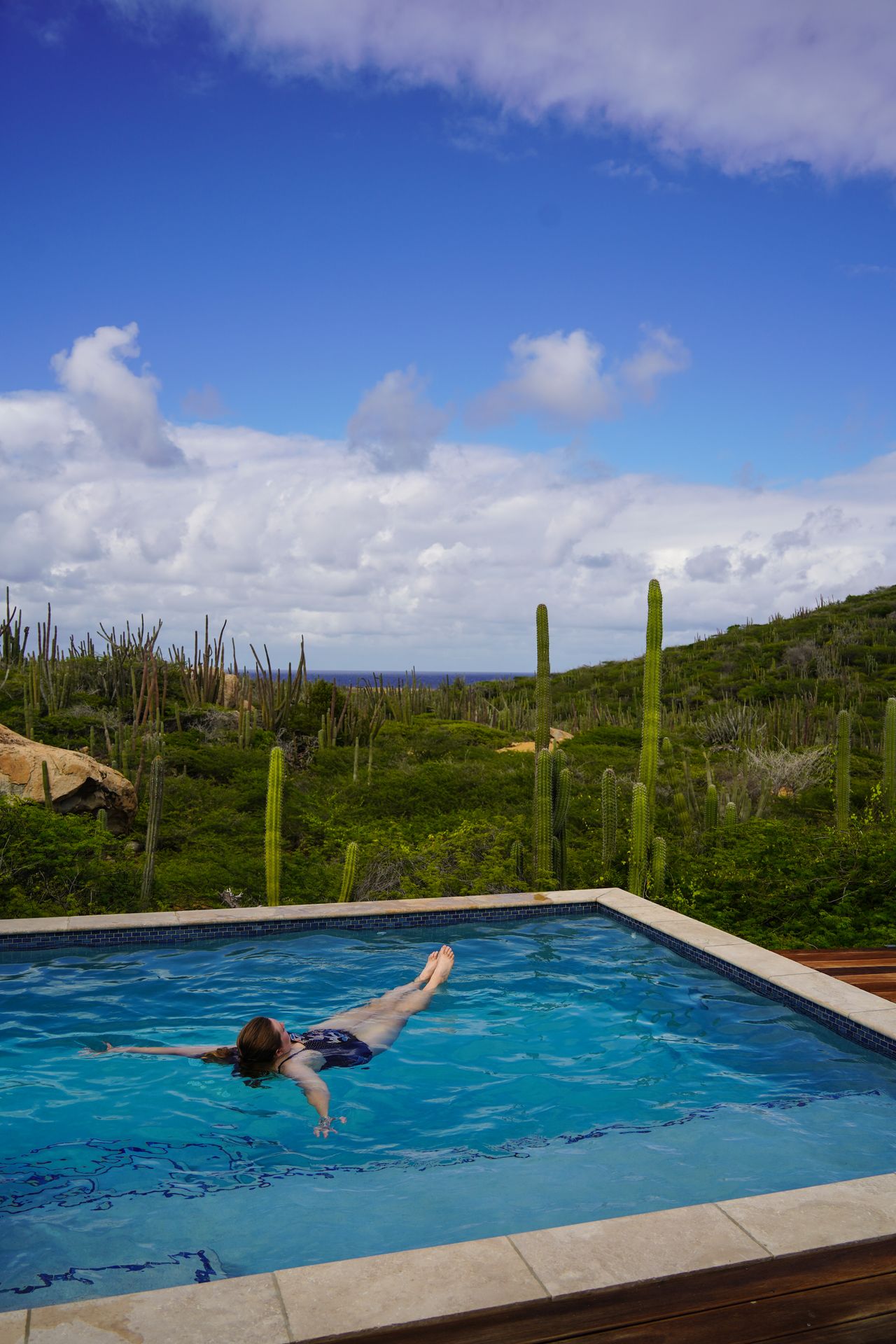

I spent the majority of my nights in Aruba at the Aruba Airstream, and had an INCREDIBLE stay here! The airstream is located in a quiet and secluded part of the island, and has its own pool and private hiking trails. Inside the airstream, there were two beds, a sitting area and high quality kitchen items. However, the outdoor space was the main draw of this special place.
Not only is there a pool, but there’s a hammock, an outdoor shower, an outdoor toilet and a grill. And you can leave directly from the property to hike on their trails and head out to the coast of Aruba. The property is very close to the Aruba Natural Bridge, the Cave Pool and the Bushiribana Ruins.
This is also an incredible place for bird watching. The owners of the airstream actually have a nature conservancy and work to protect the birds in the area. We saw tons of birds from the Airstream, and they even gave us a bird identification sheet and a bird calendar to take home.
I can’t say enough good things about this stay. It was the perfect place to have a different experience than the main hotel stretch, and gave us a chance to cook, relax and feel immersed in nature.
Book the Aruba Airstream on vrbo
Hotels in Aruba
I also spent a couple nights at a couple different hotels in Aruba.
If you want to be right in the action with lots of access to restaurants and bars, Palm Beach is a great area to stay in. If you prefer an area that is a little bit quieter, but still close to the action, Eagle Beach is a really nice alternative.
Here are a few of the best hotels in Aruba:
Eagle Beach Area:
Luxury: Embassy Suites by Hilton. I stayed here for one night and thought it was a great hotel with a large pool and a nice room. Mid-Range: Eagle Aruba Resort. This is located right across from Eagle Beach!
Palm Beach Area:
Luxury: Marriott's Aruba Surf Club Mid-Range: Aruba Lagunita
On a budget? These properties are very close to both Eagle Beach and Palm Beach, but not as close to the ocean. You can save a lot by going just a few more minutes away from the ocean.
Where to Eat in Aruba
I cooked at the Aruba Airstream for most of my trip (going to the grocery is a great way to save a little bit of money on an expensive island), but here are the restaurants that I enjoyed during my Aruba trip! I looked for places that offered traditional Aruban or Dutch food, and that were vegetarian friendly.
Huchada
Huchada is a local bakery and lunch spot that serves pastechis (a deep-fried pastry that is traditional on the ABC Islands), a variety of other pastries, sandwiches, and more.
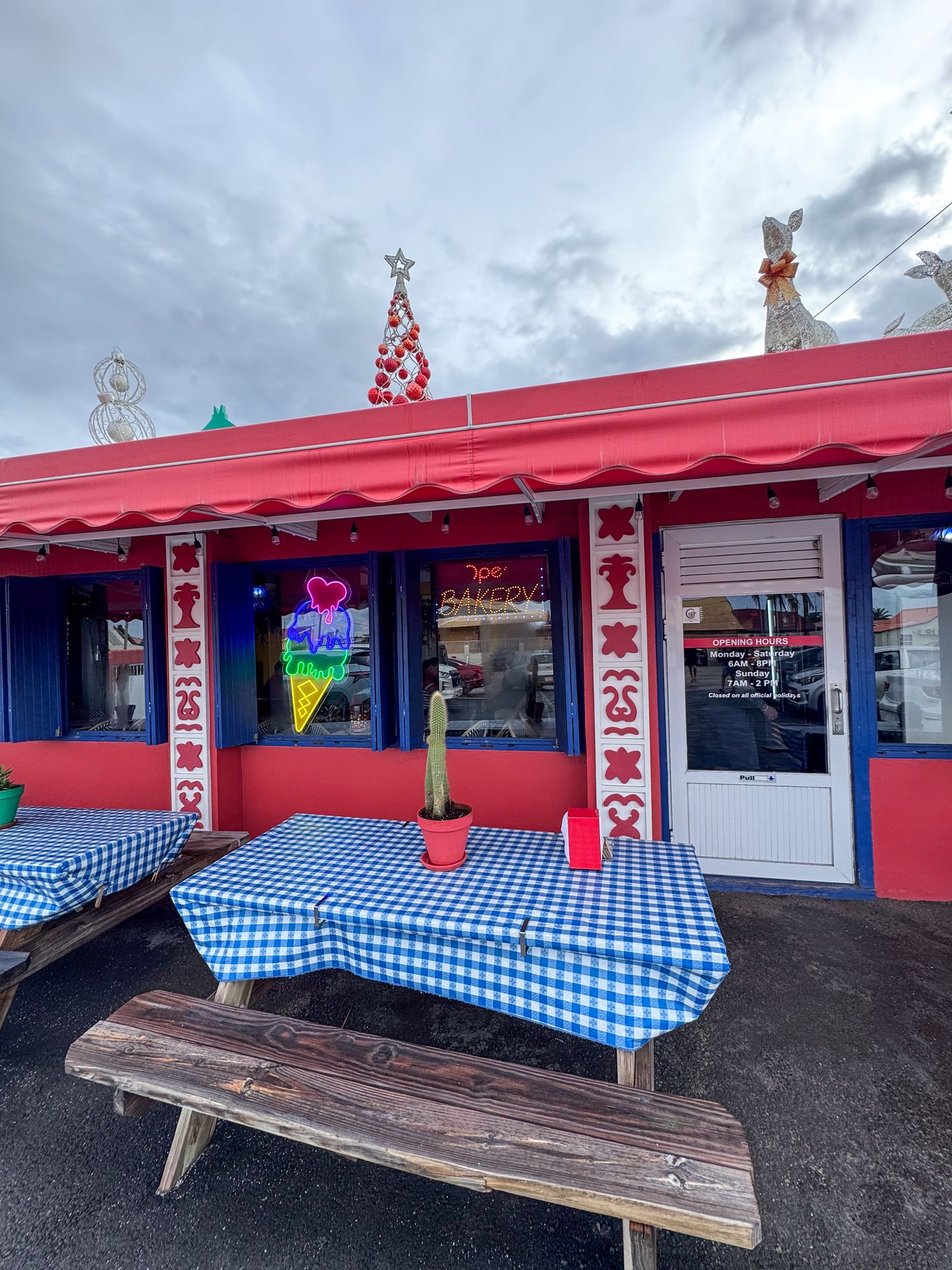

I really enjoyed the cheese pastechi - it was light, airy and had the perfect amount of sweetness. My friends enjoyed the pastechis with meat as well.
Tip: Huchada is close to the Ayo Rock Formations and the Hooiberg Trail. Go early to ensure the pastechis don’t run out, and expect a line.
Lima Bistro
Lima Bistro is a wonderful restaurant if you’re looking to splurge on a nice meal during your time in Aruba. This is primarily a Peruvian restaurant with an Aruban twist.
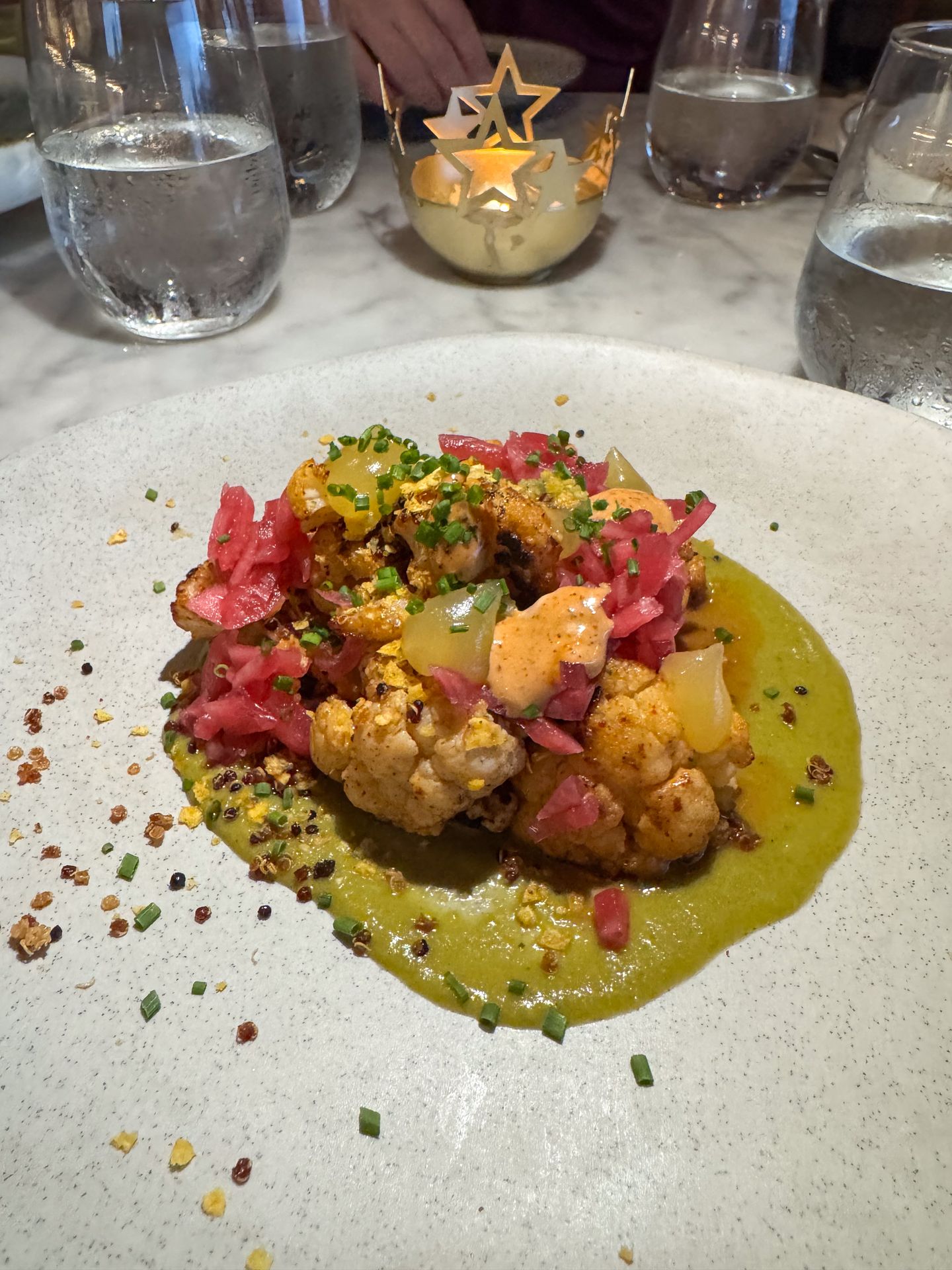
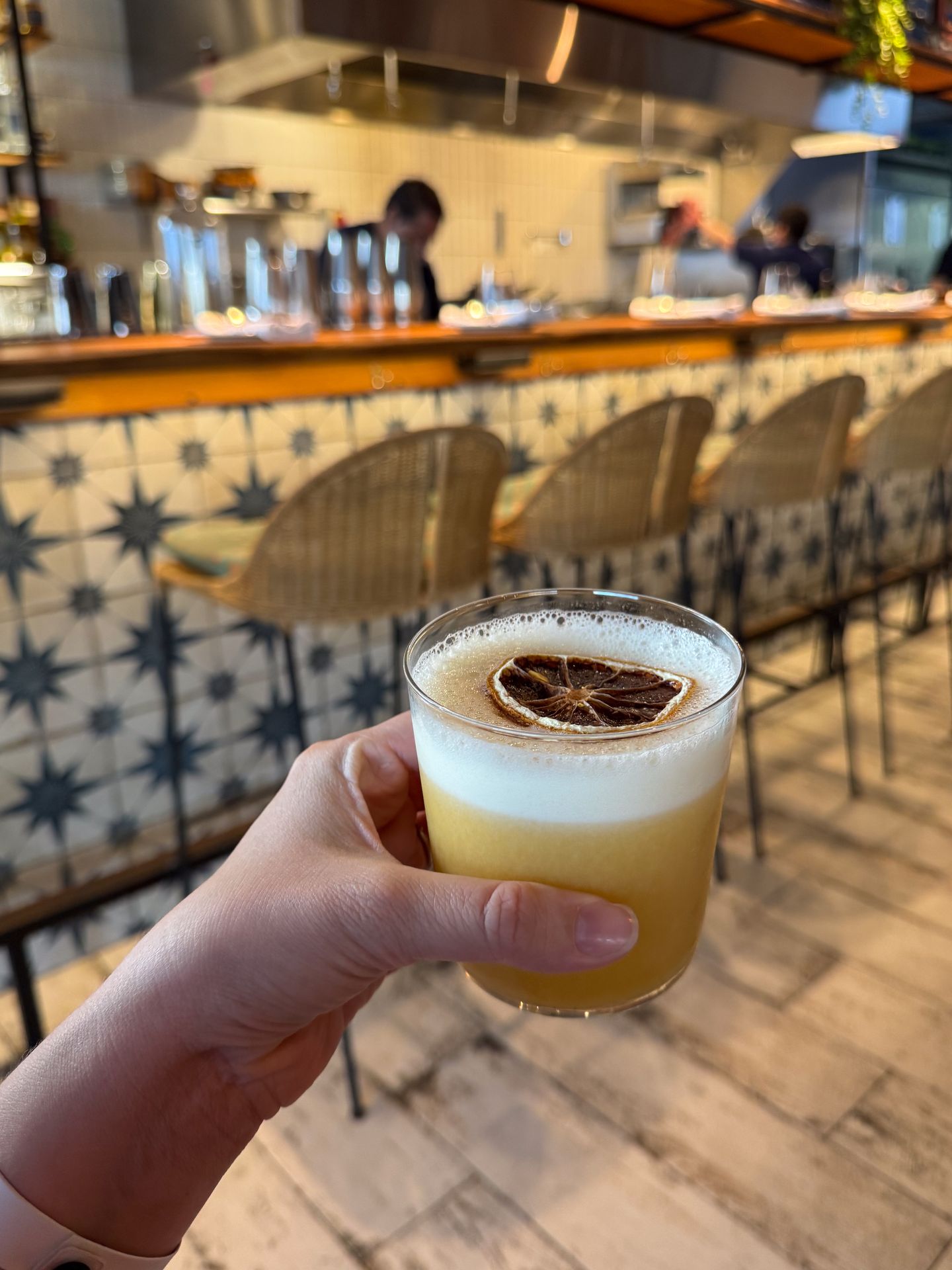
They serve a variety of small plates and have a nice selection of vegetarian options, and the space feels elegant and modern.
I really enjoyed the maitake mushroom, the grilled cauliflower al pastor, and the maracuja sour cocktail. The dishes all had a beautifully balanced mix of texture and flavors. This is a great spot for a date night or for foodies.
The Dutch Pancake House
Dutch pancakes are a very popular dish in Aruba, and The Dutch Pancake House is a great spot to enjoy them. Traditional Dutch Pancakes, or pannankoeken, are huge, plate-sized pancakes that are thin (similar to crepes). They can be served either sweet or savory. I really enjoyed a savory pancake topped with brie and herbs.


You can also get poffertjes here, which are miniature dutch pancakes. We had the poffertjes dessert, which had toppings like ice cream and chocolate.
The West Deck
The West Deck was an unassuming restaurant that we found when looking for a restaurant close to the airport, and it ended up being a great spot. The restaurant sits right on the beach with great views, and has several Dutch and Caribbean food options.
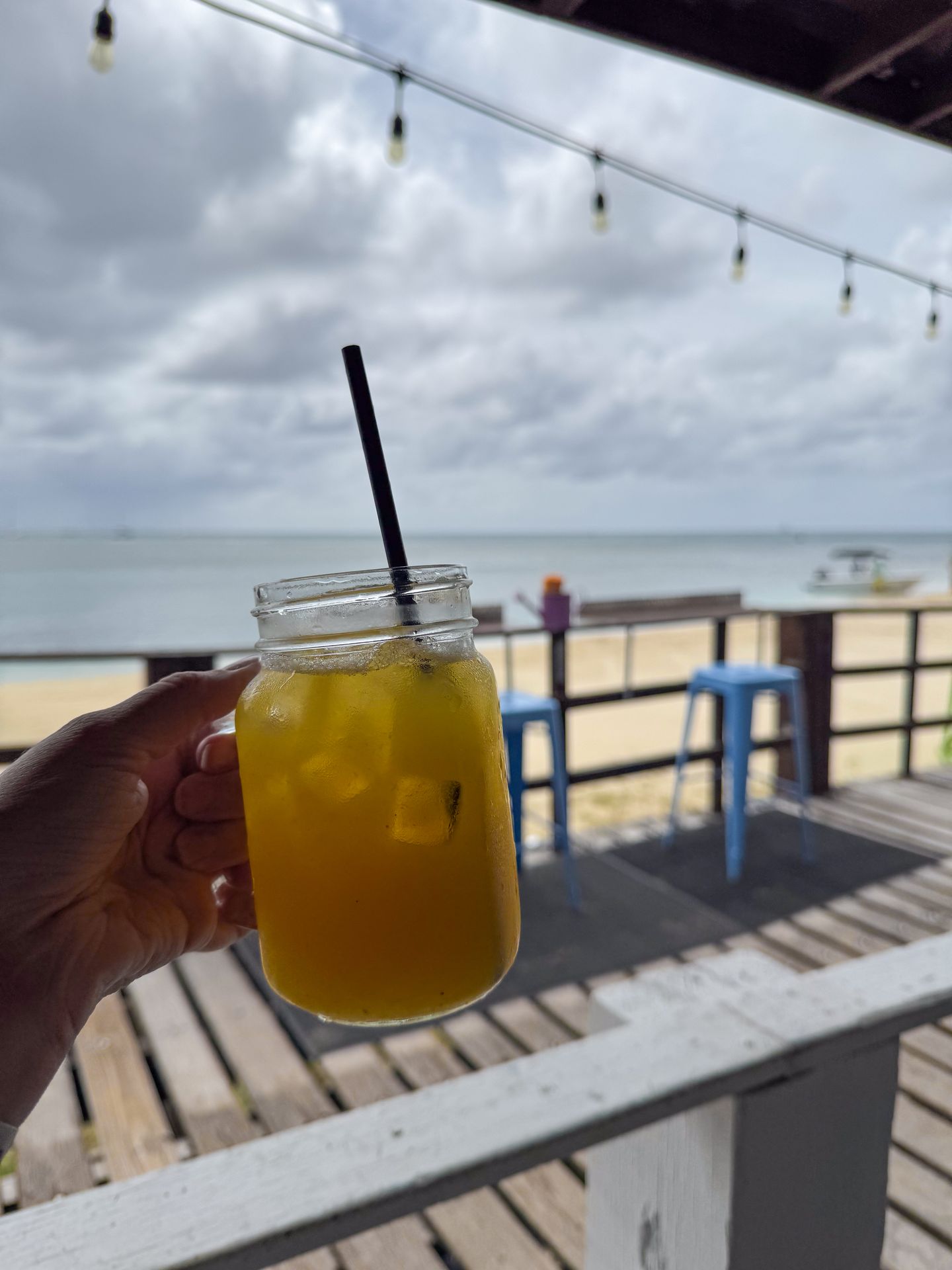

We enjoyed the fried funchi served with Dutch cheese (a popular Dutch Caribbean dish similar to fried polenta), the Caribbean bread basket, and more. Plus, we got to watch the seagulls as we enjoyed our meal.
Final Thoughts
I hope this guide helps you plan a fun and adventurous trip to Aruba! From rock formations to hidden swimming spots to beautiful birds, Aruba is a wonderful island for both beach-goers and those who love nature. After a trip to Aruba, I’m sure you’ll realize why it’s named “One Happy Island.”
For more warm-weather destinations, check out these guides:
- How to Spend a Week in Guatemala
- How to Spend 3 Days in Oaxaca, Mexico
- How to Spend 3 Days in Mexico City
- A Guide to Hiking the Acatenango Volcano in Guatemala
- An Epic Florida Keys Road Trip Itinerary
- How to Spend 3 Days in Sedona, Arizona
Thanks for Reading!
Let's stay in touch!
Join the Lost with Lydia email list to get monthly travel guides and tips!
